Sentence analysis Lecture 3. 1. Syntactic relations in

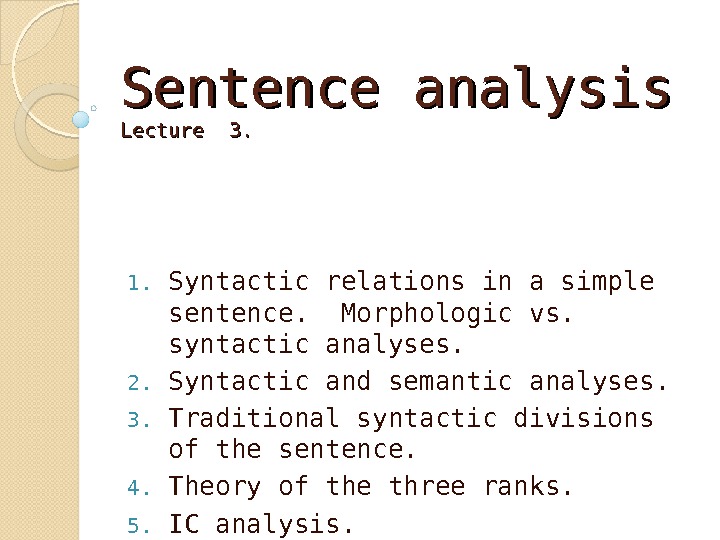
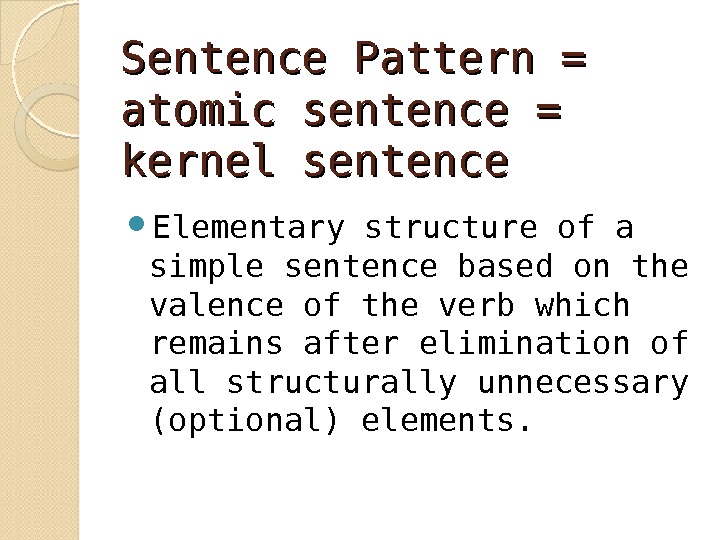
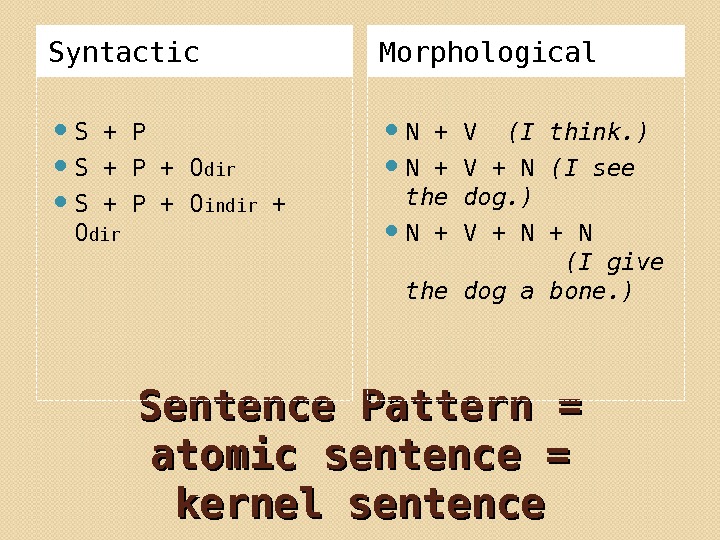
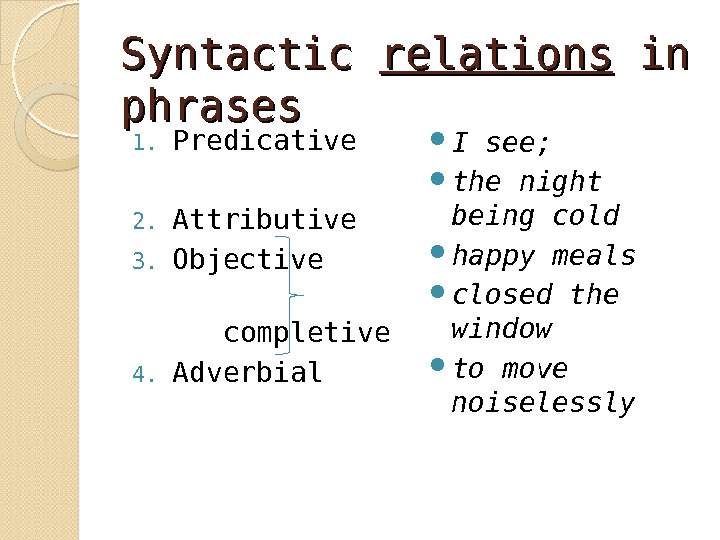
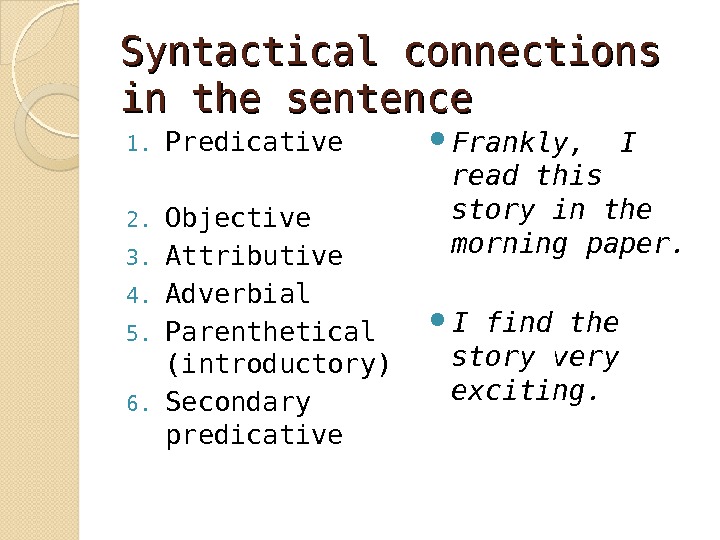
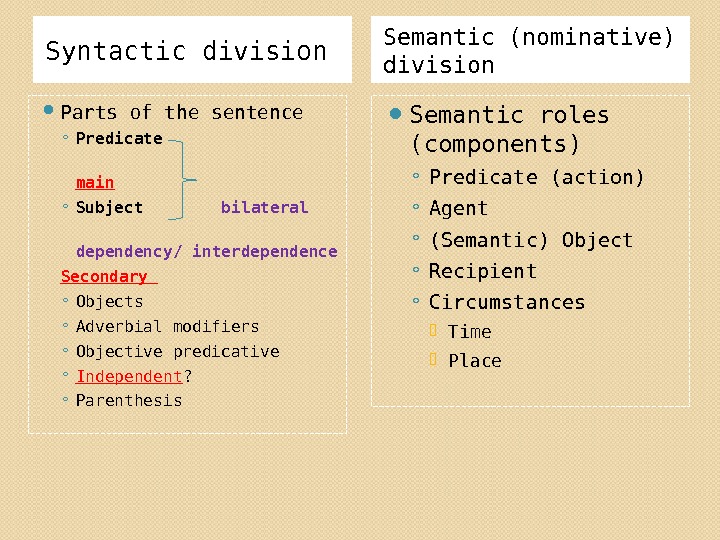
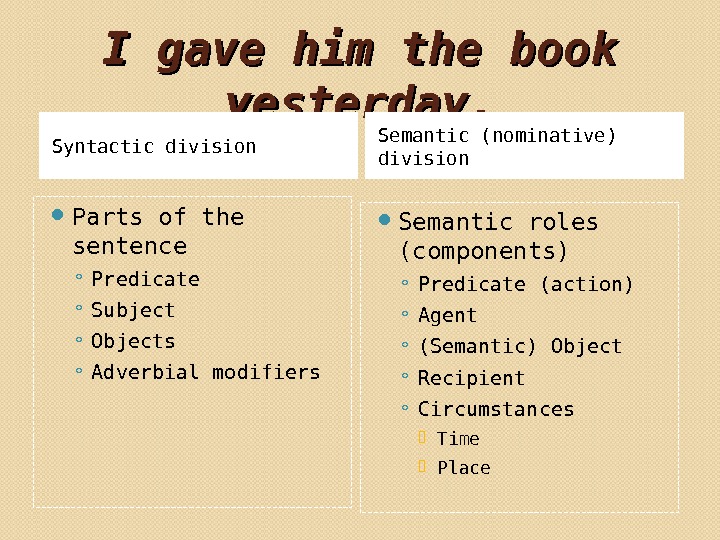
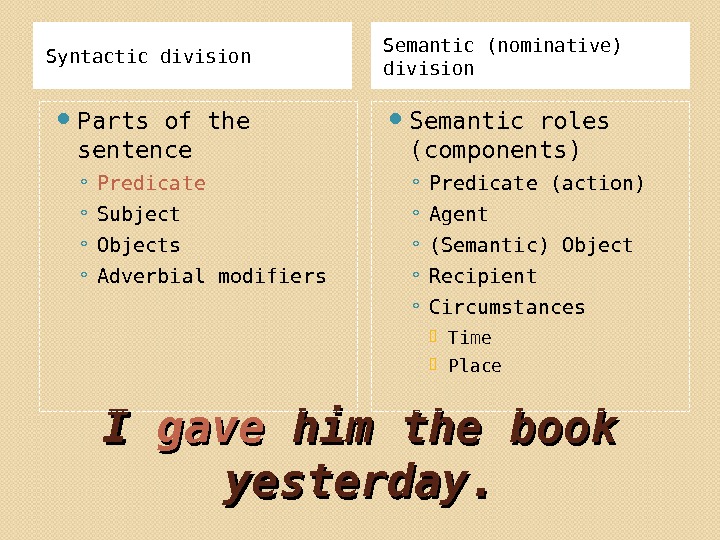
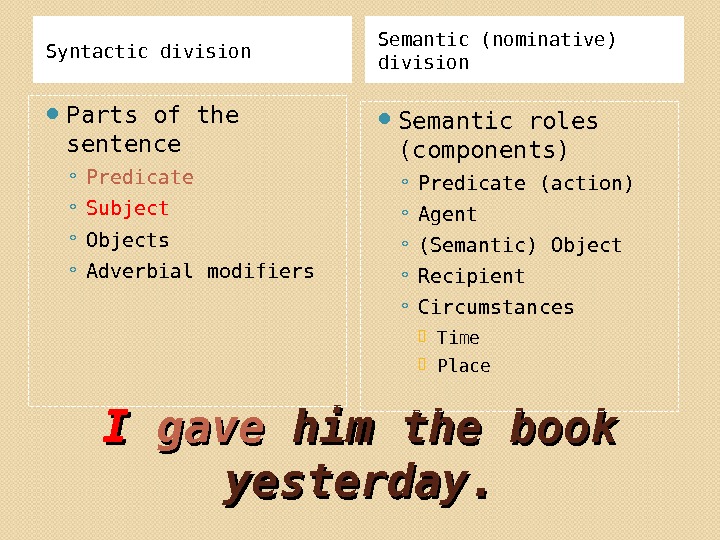

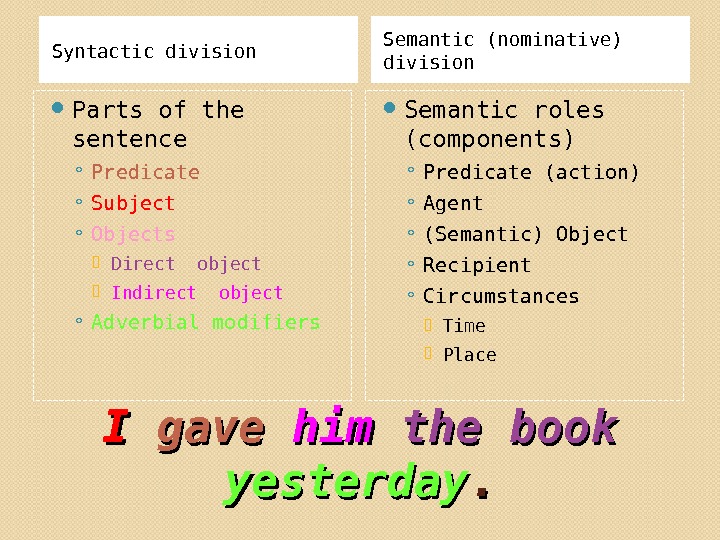
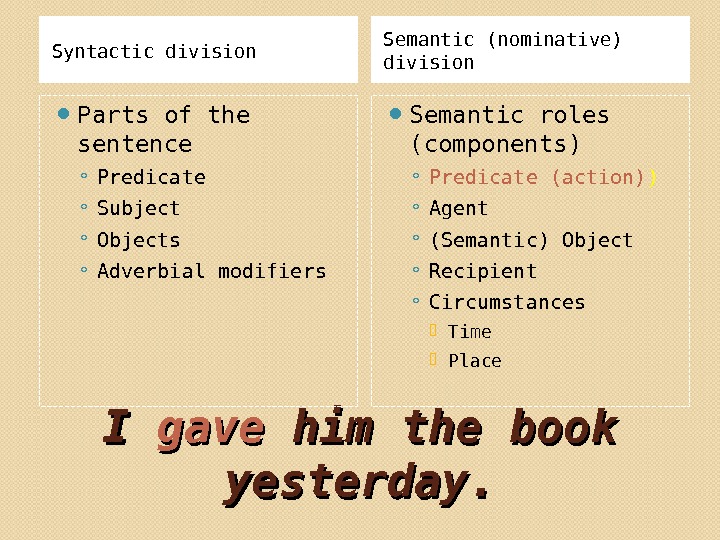
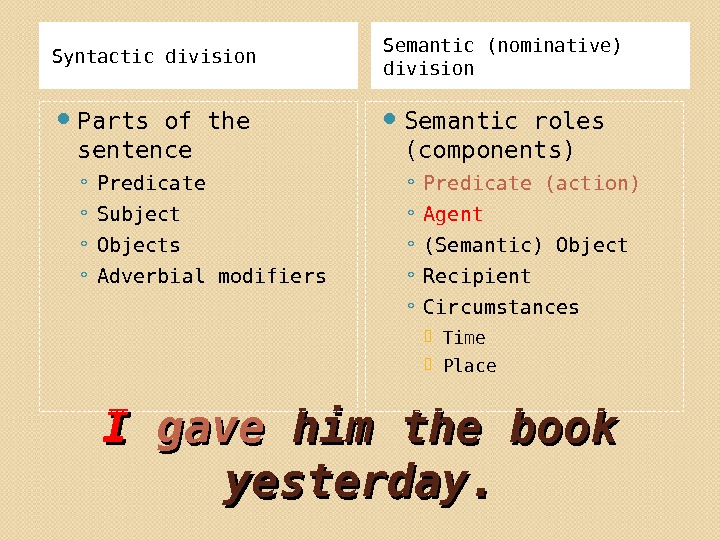
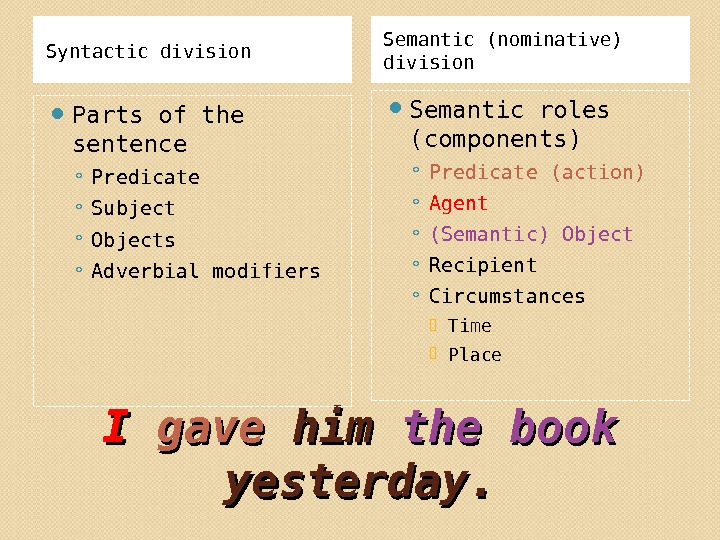
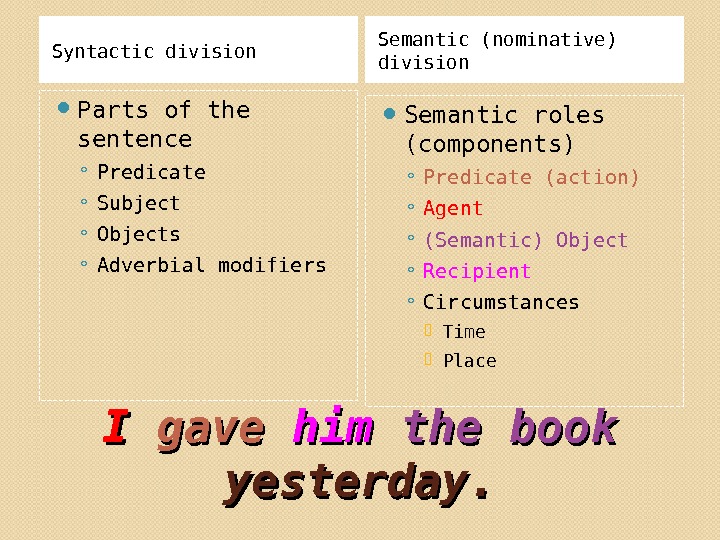
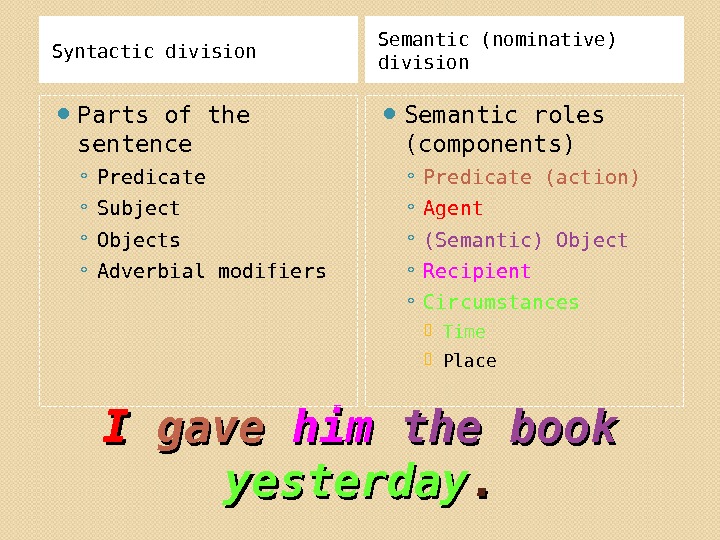
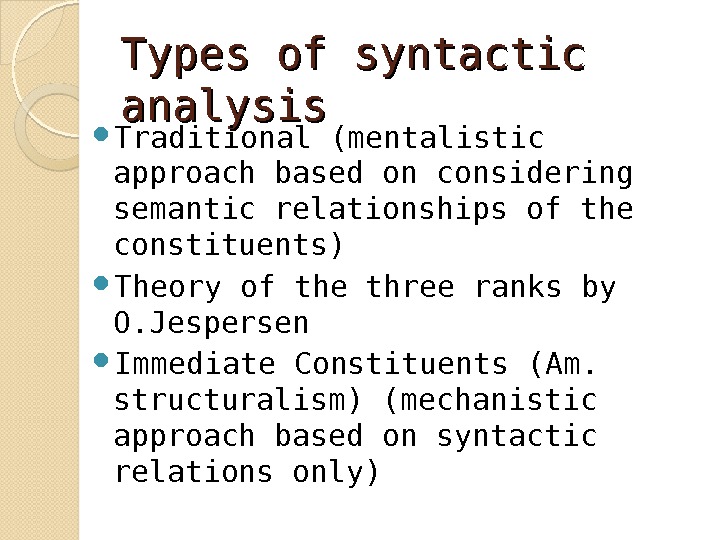

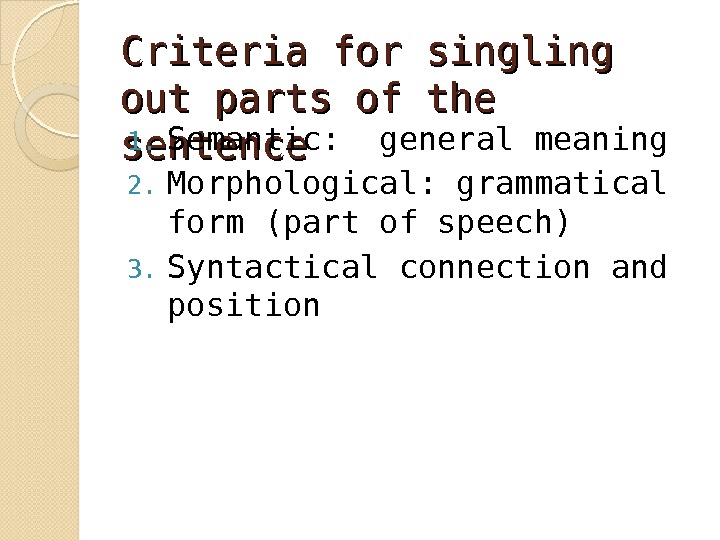
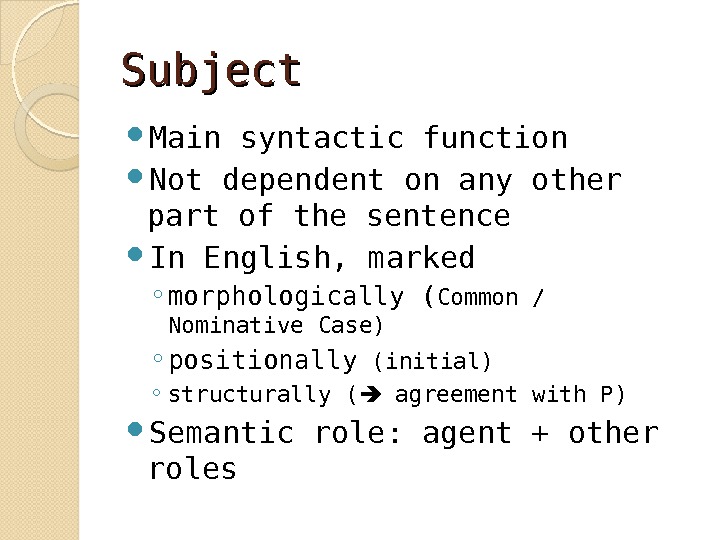
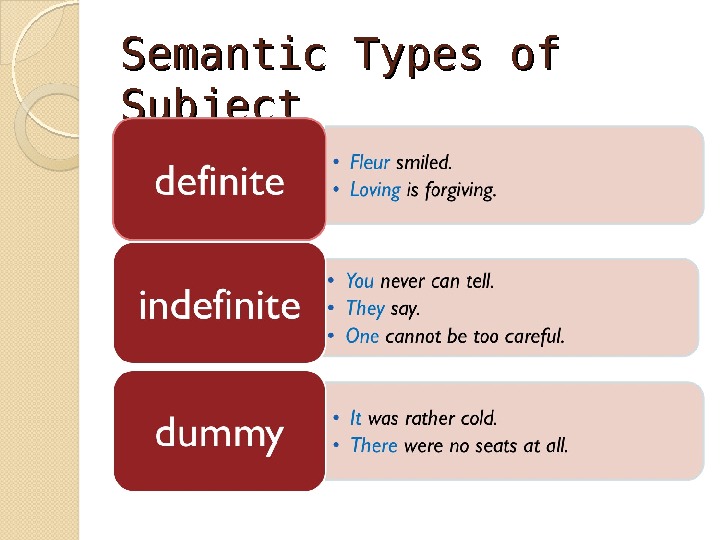
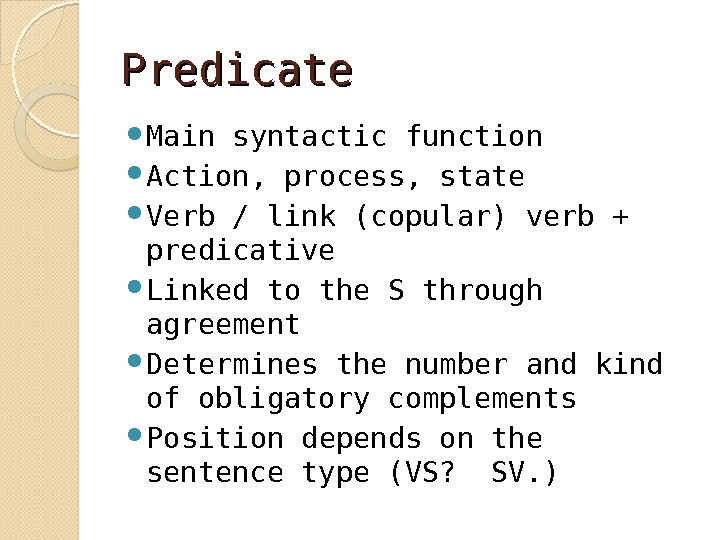
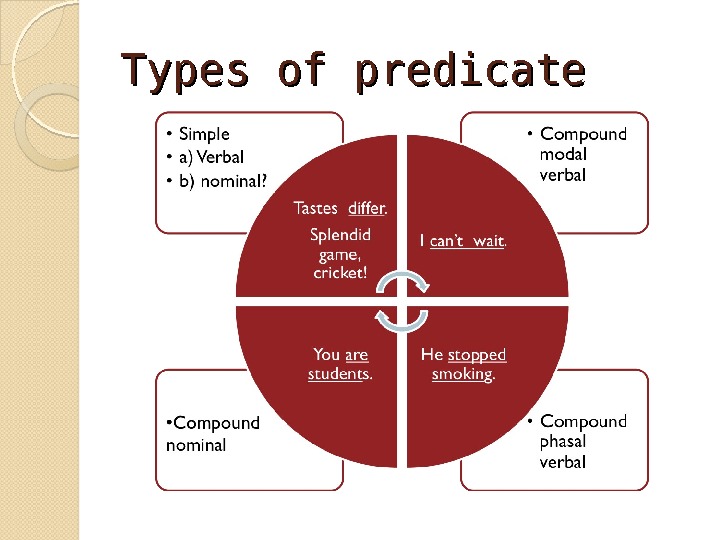
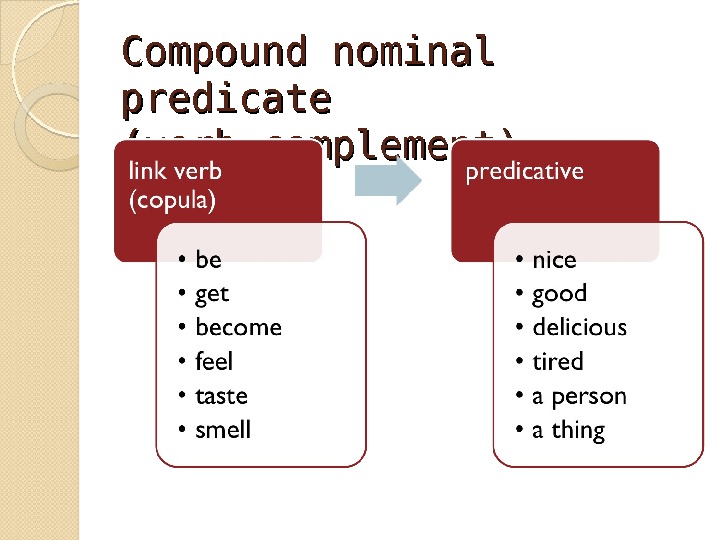
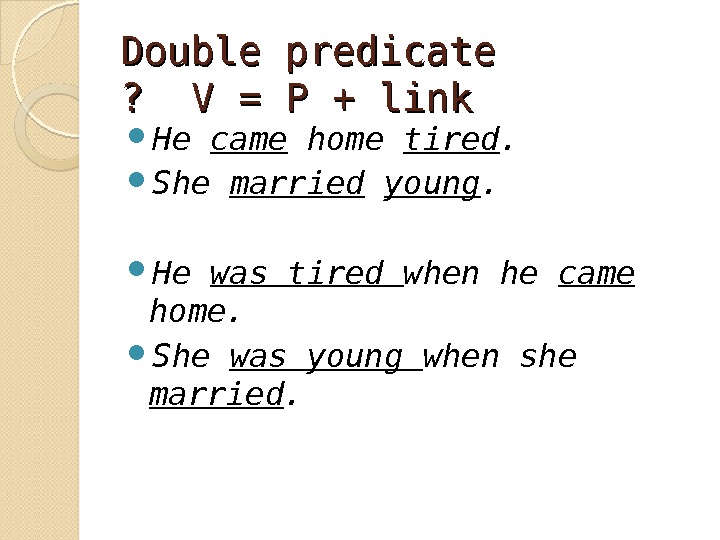
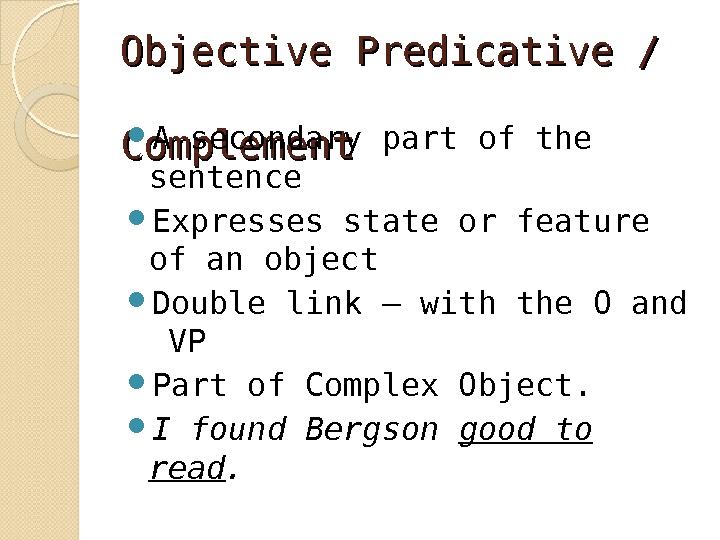
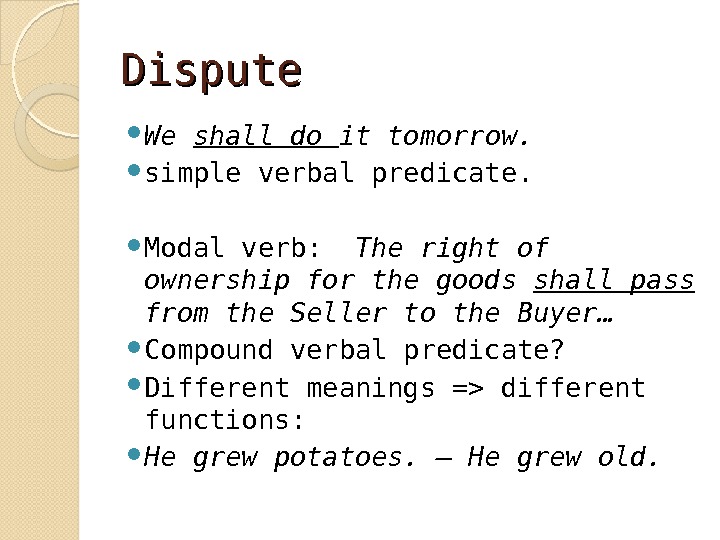
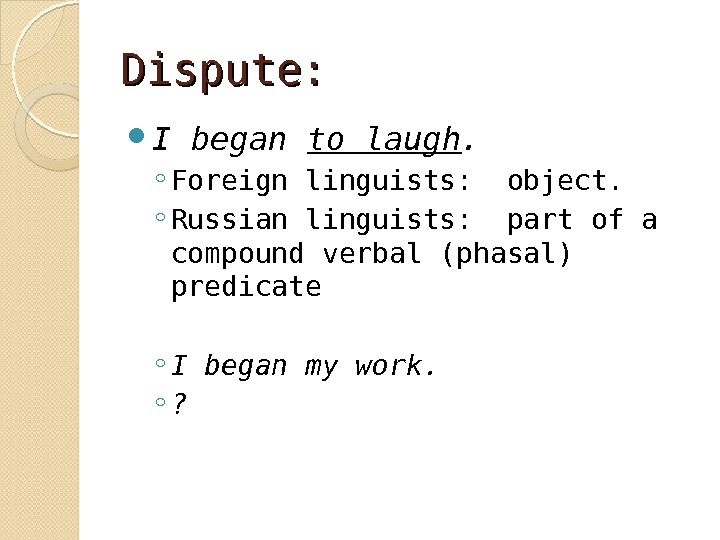
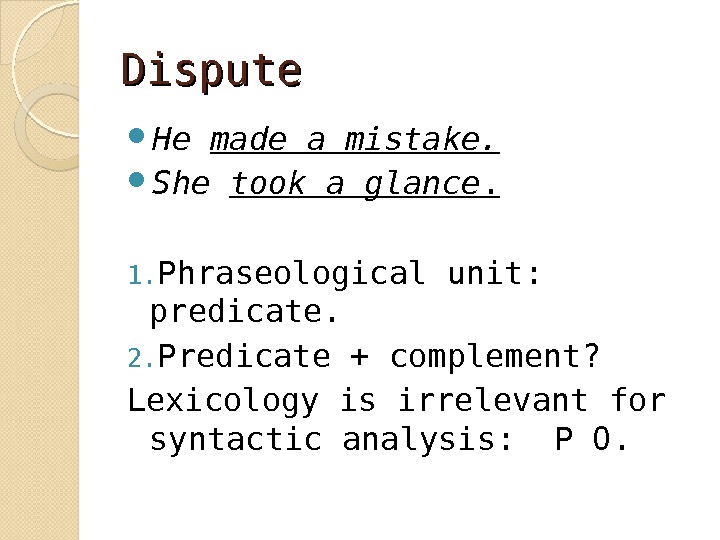
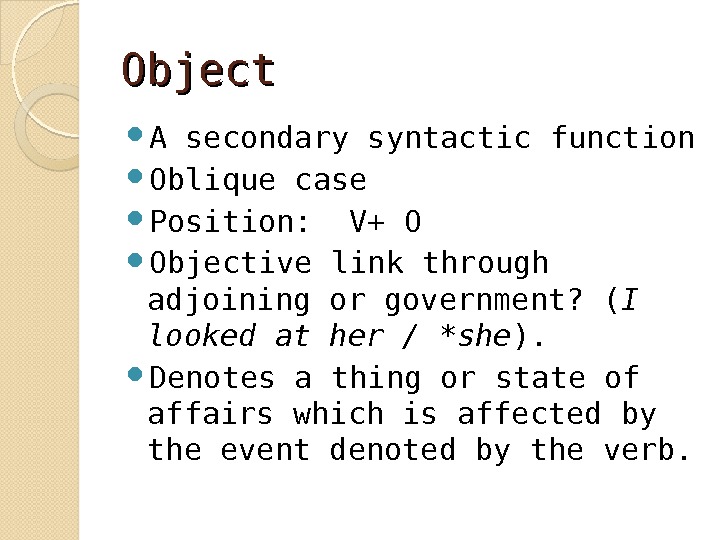
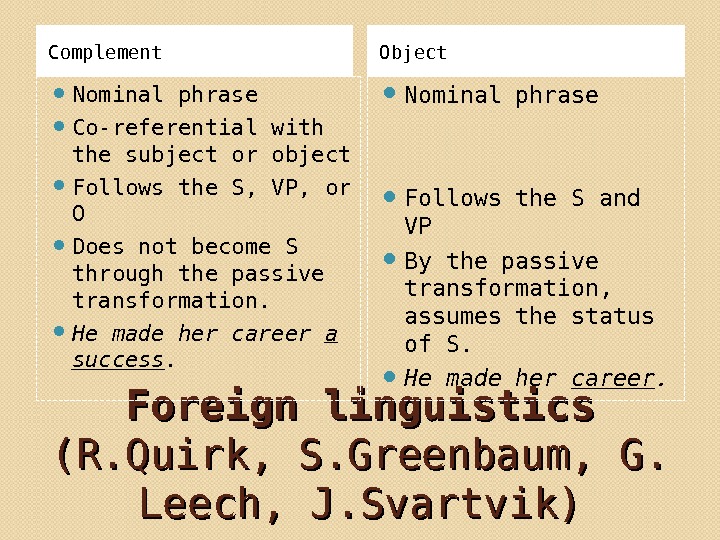
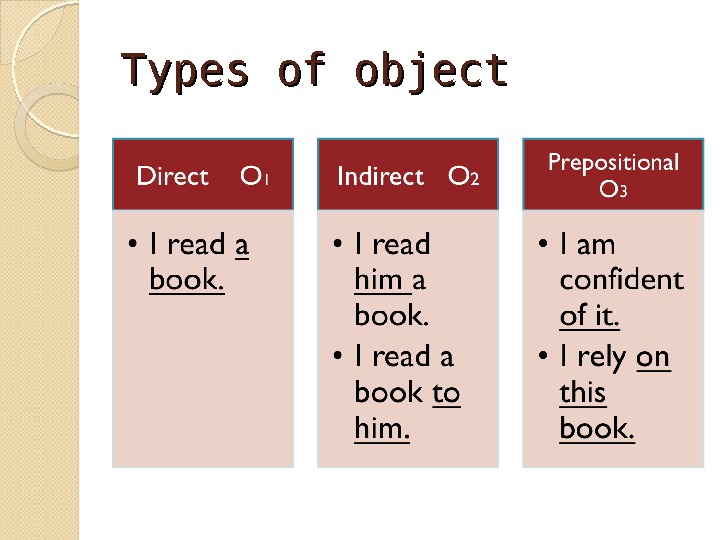
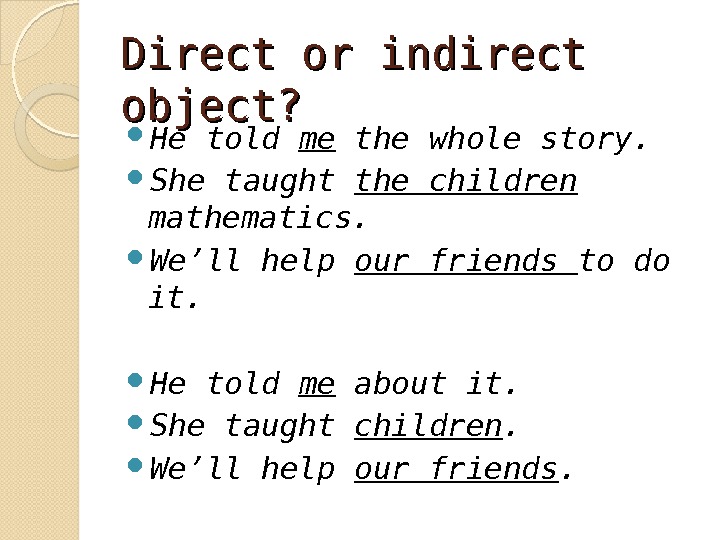
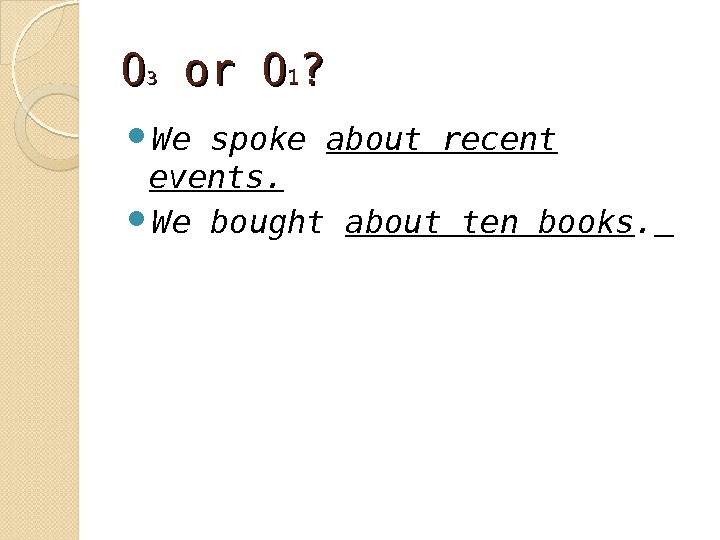
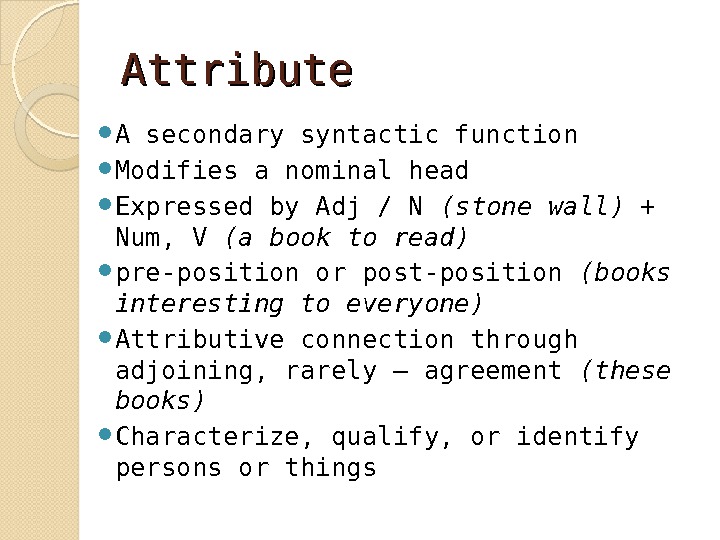
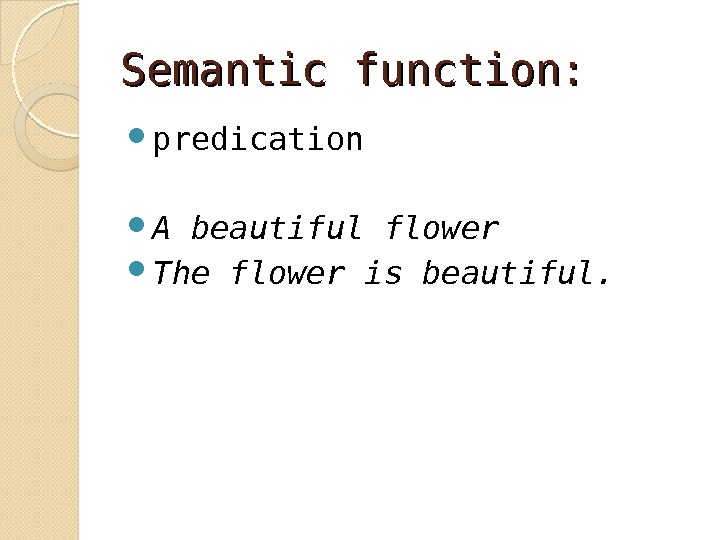
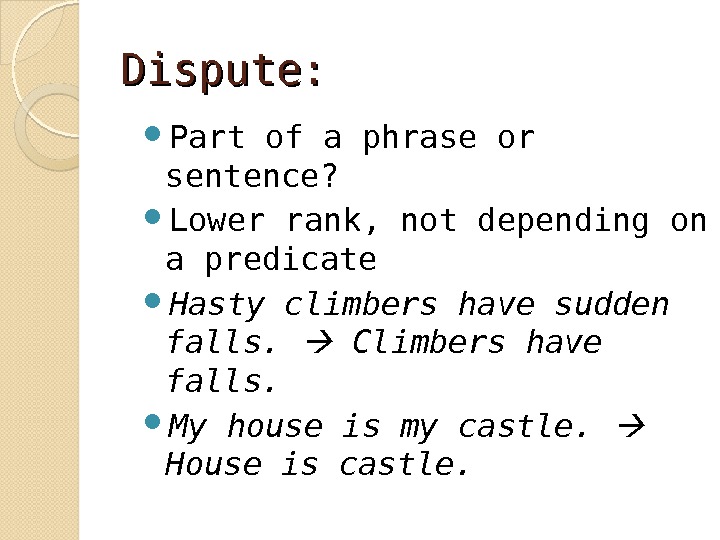
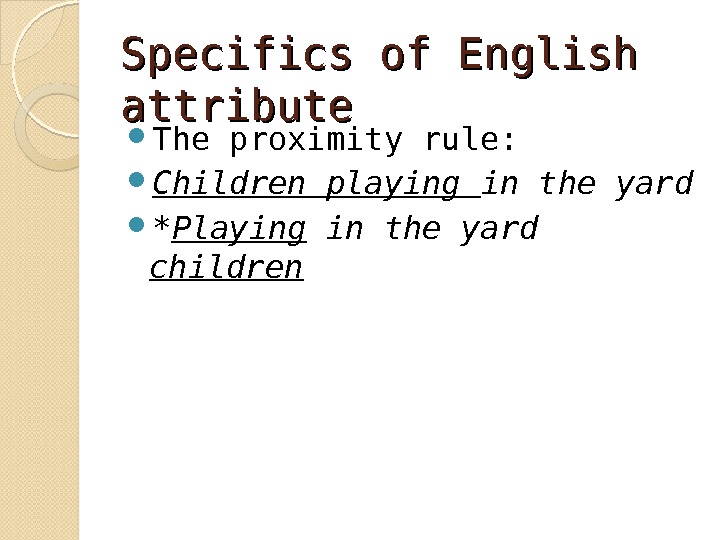
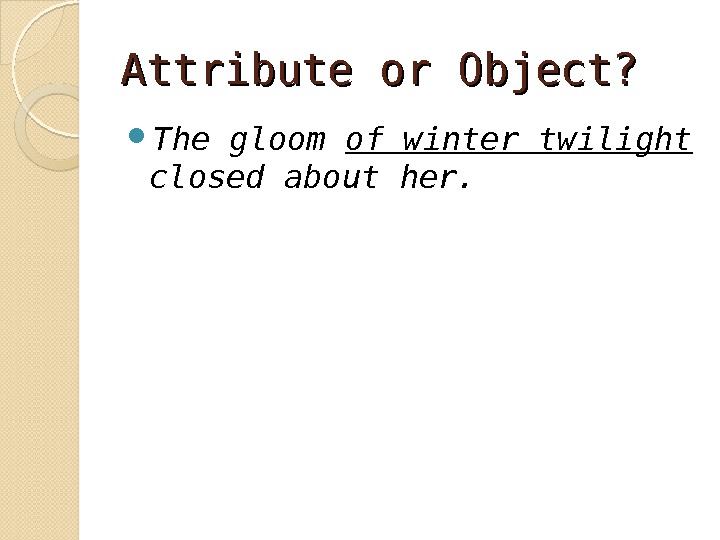
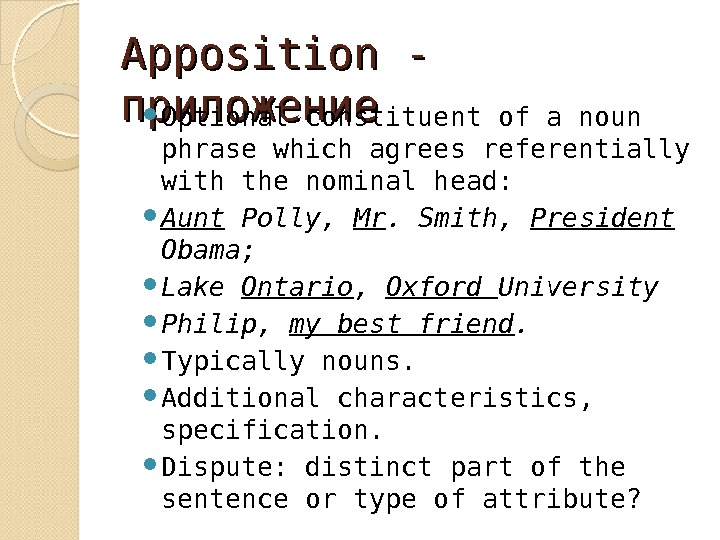
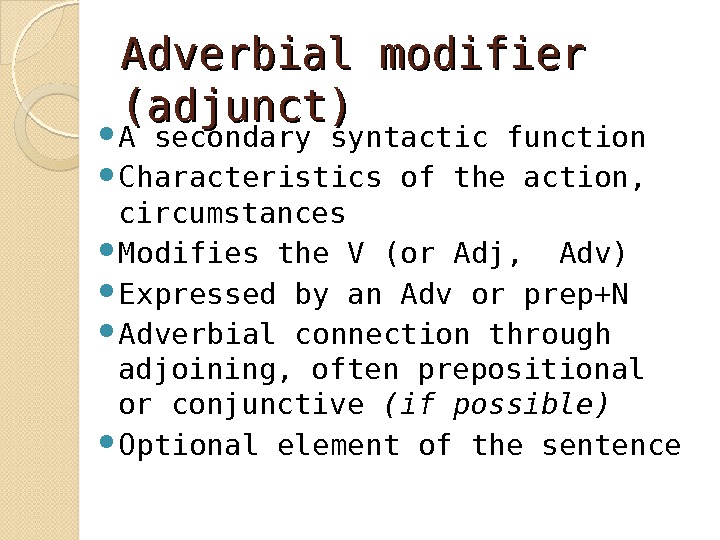
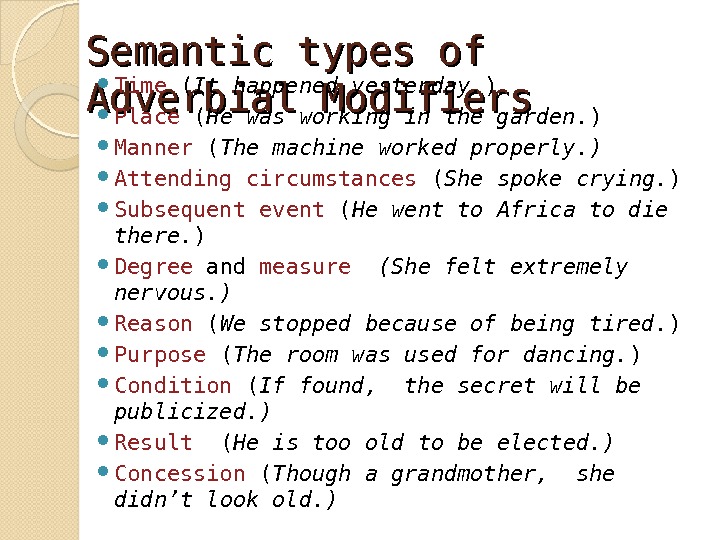
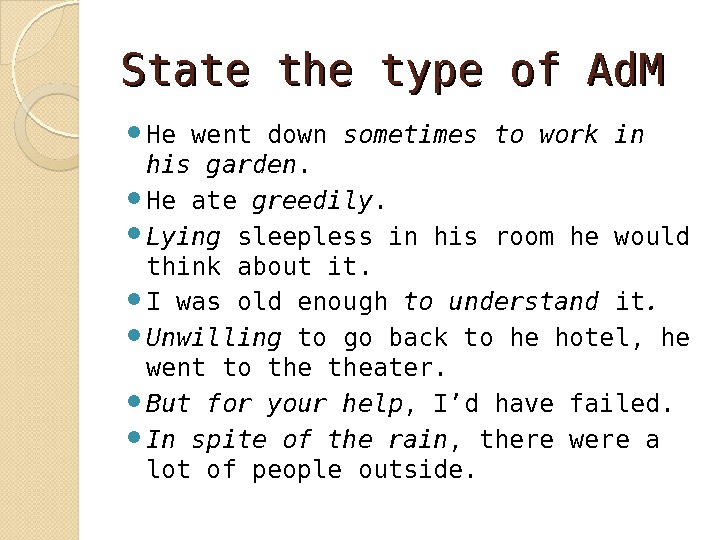
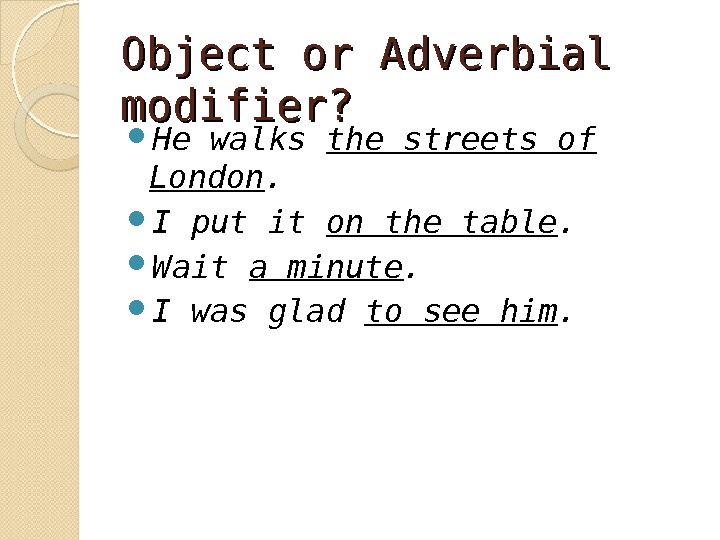
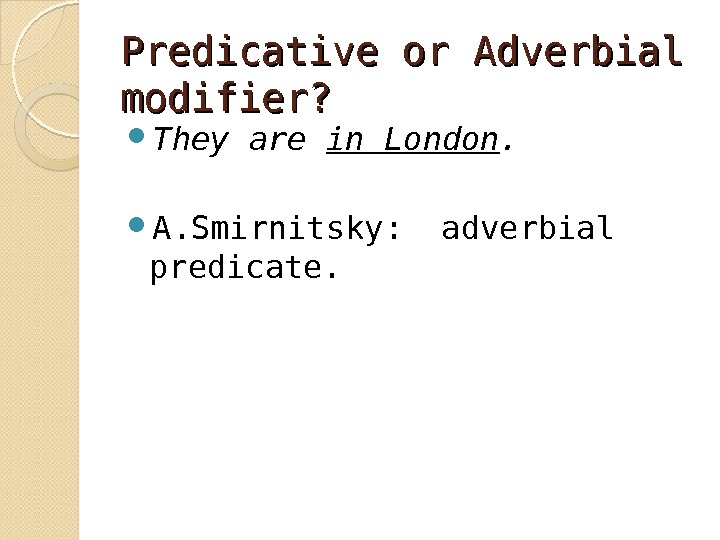
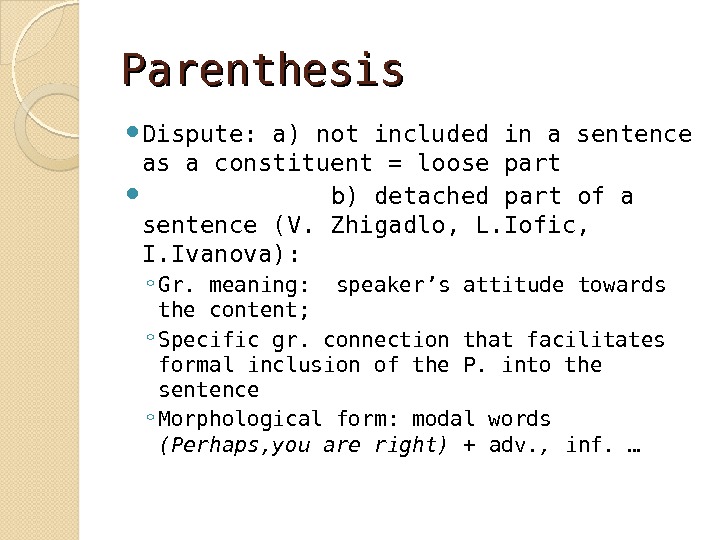
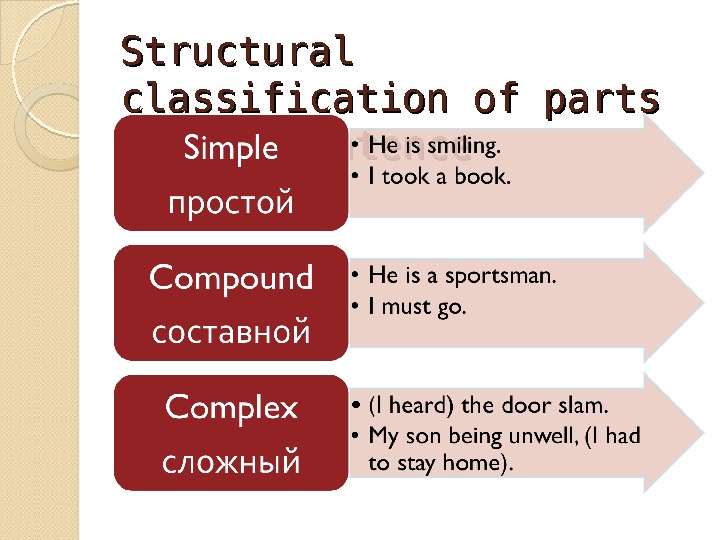
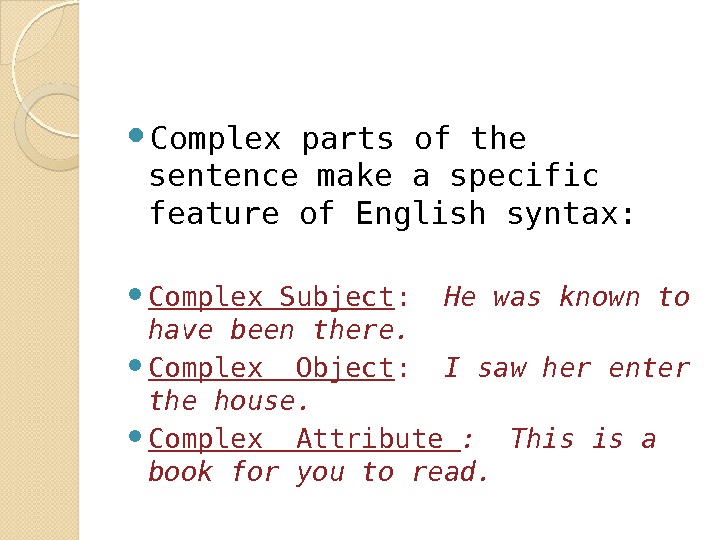
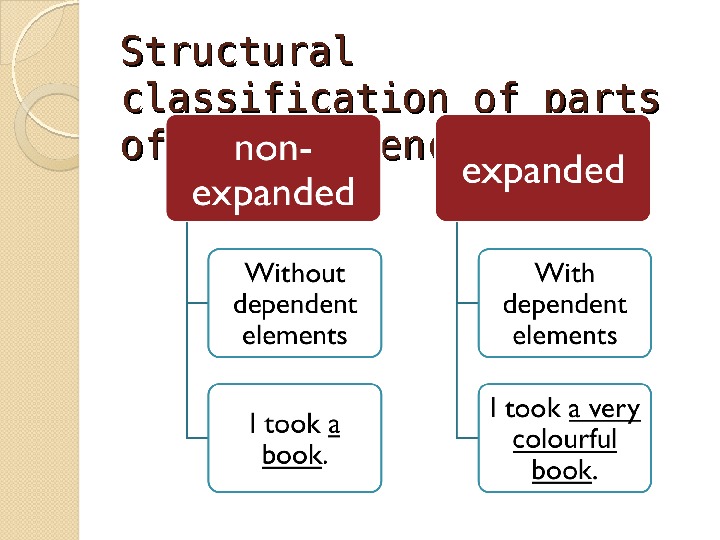
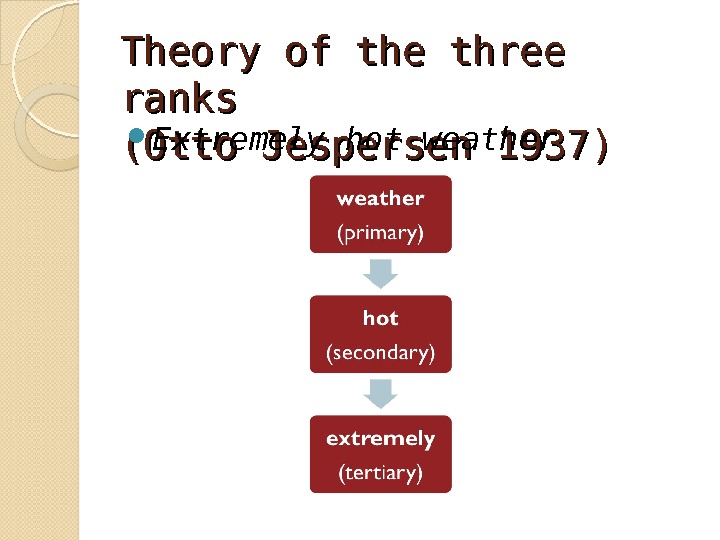
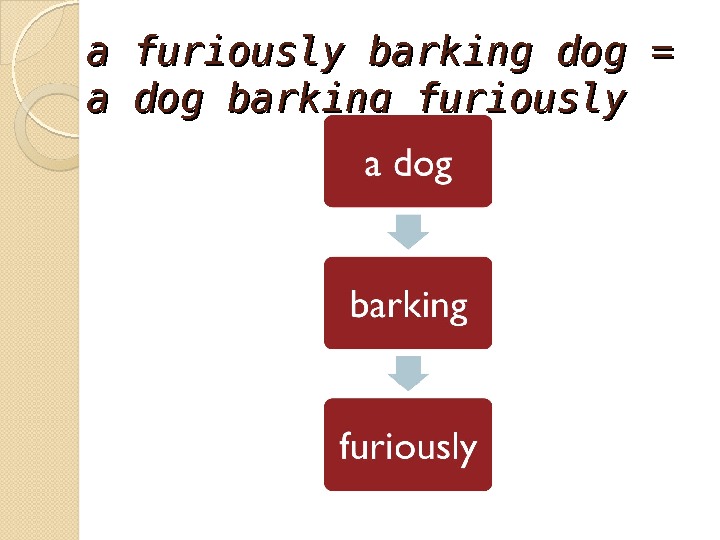
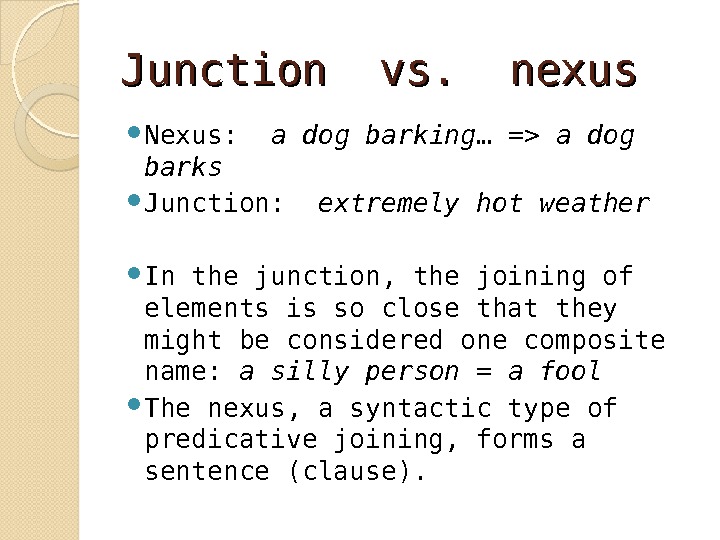
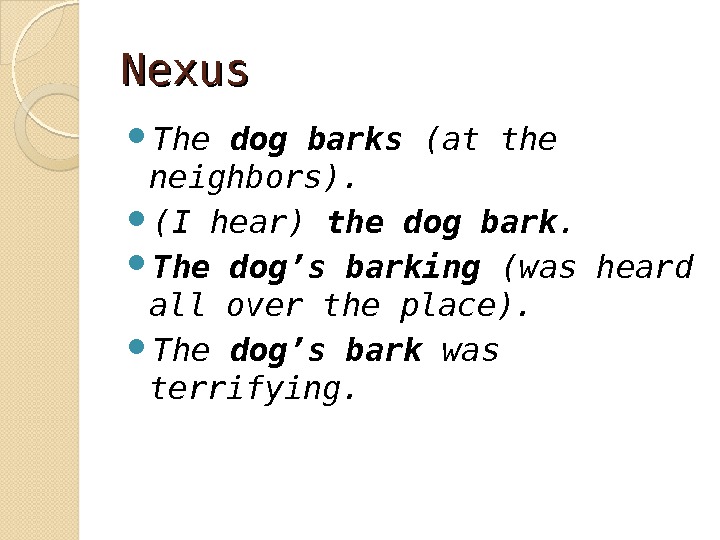
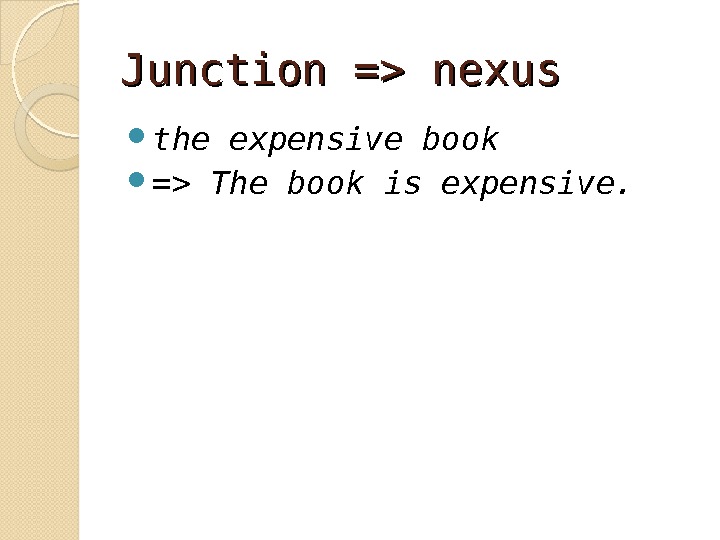
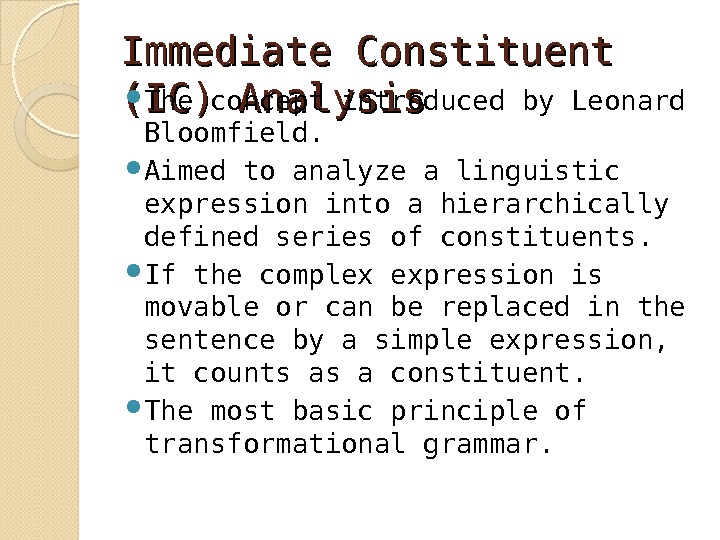
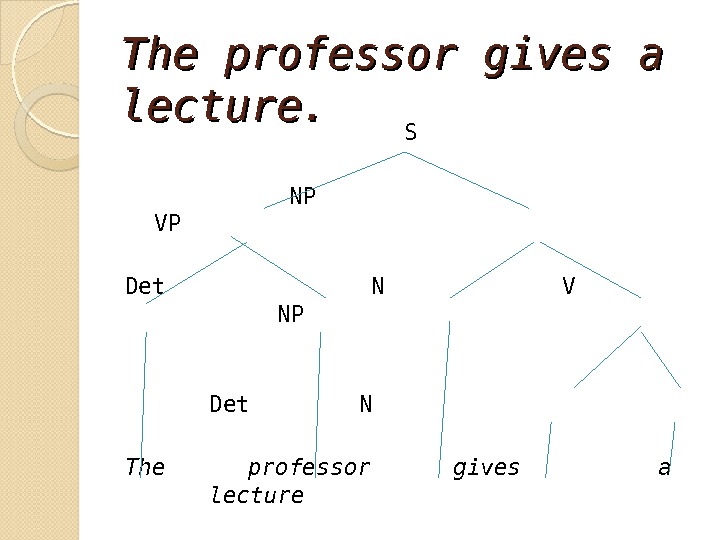
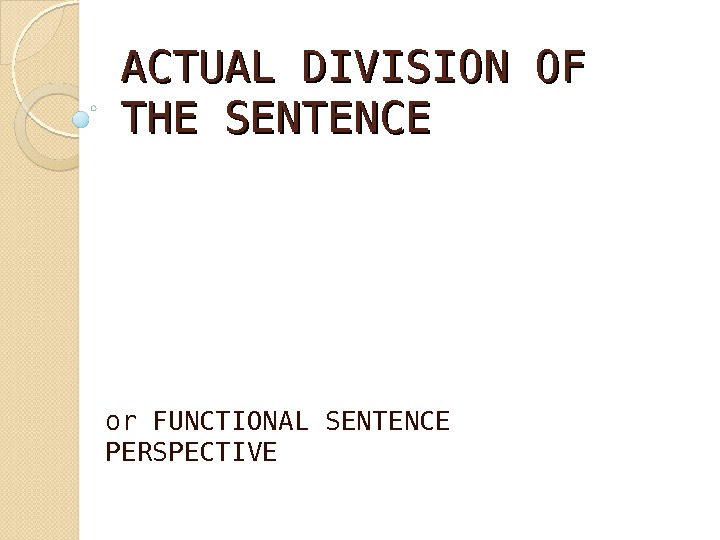
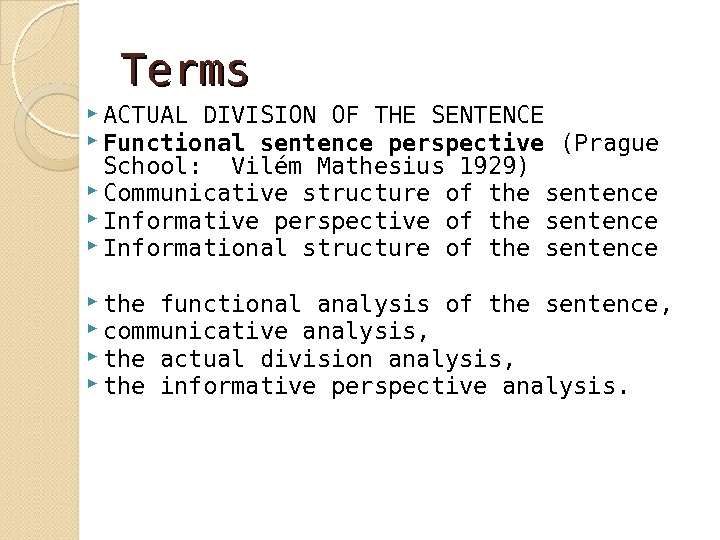
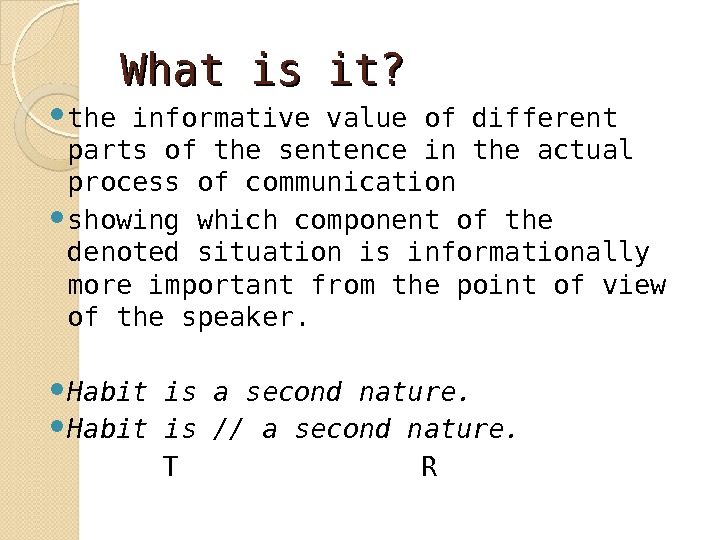
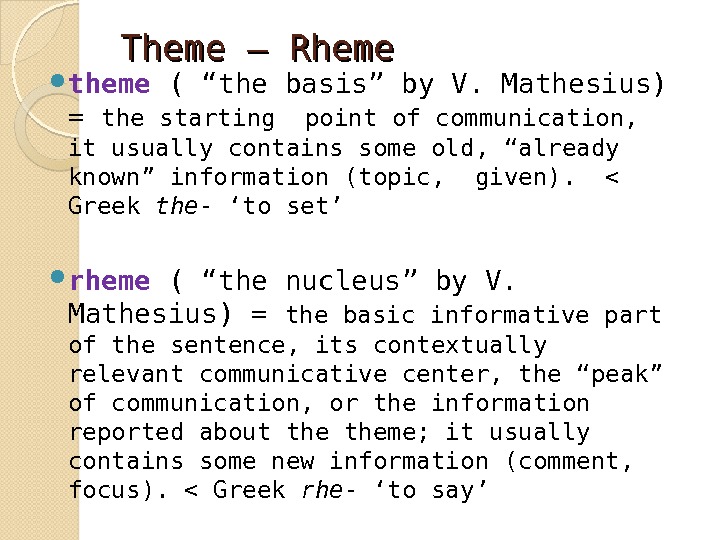
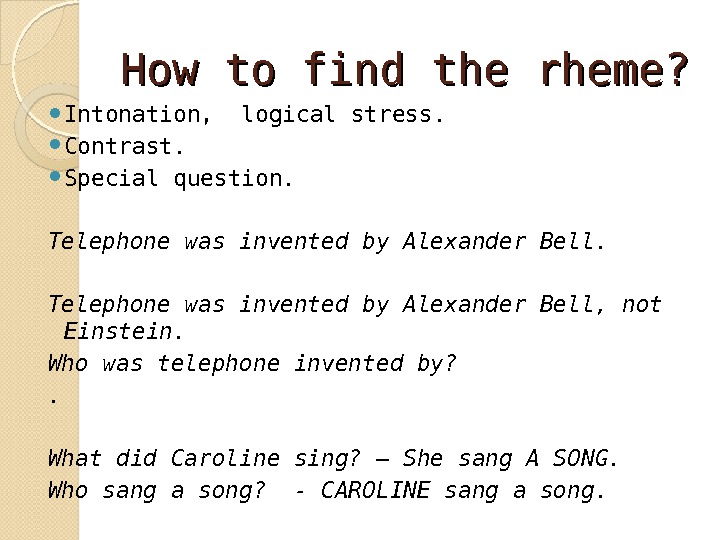
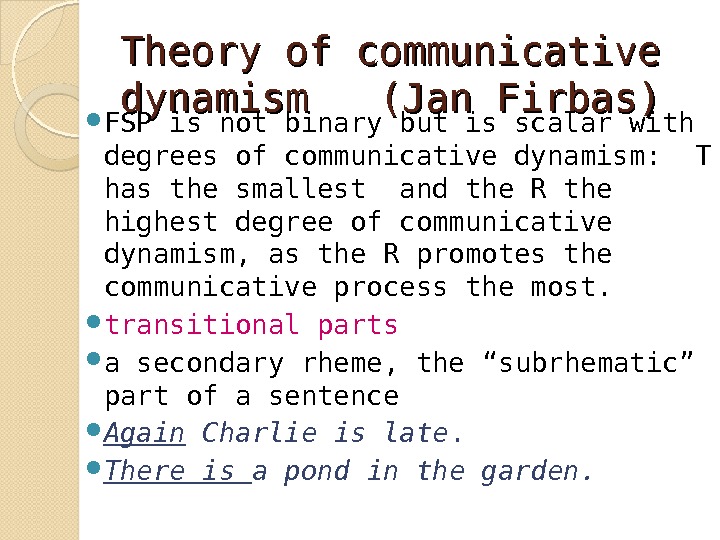
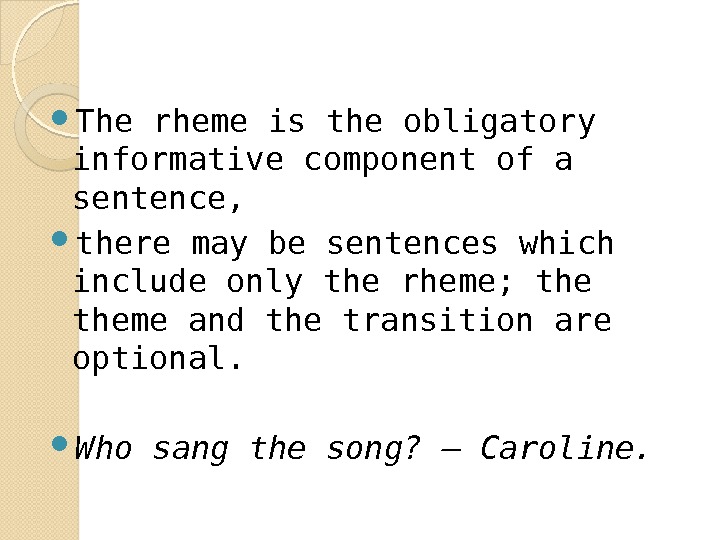
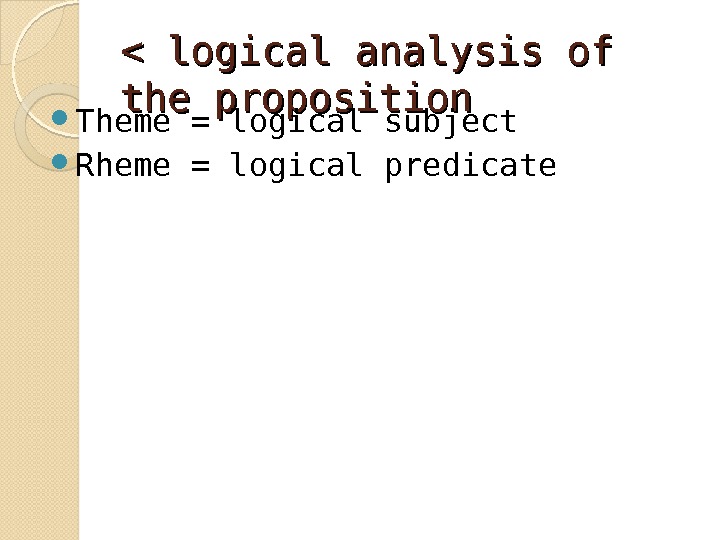

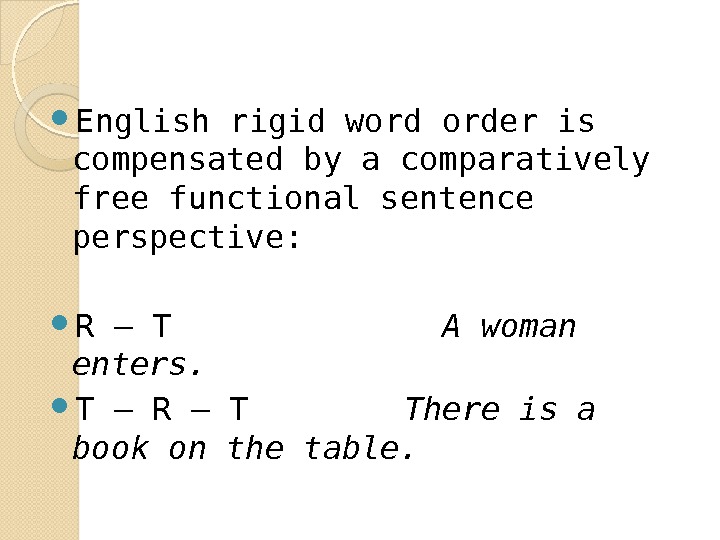
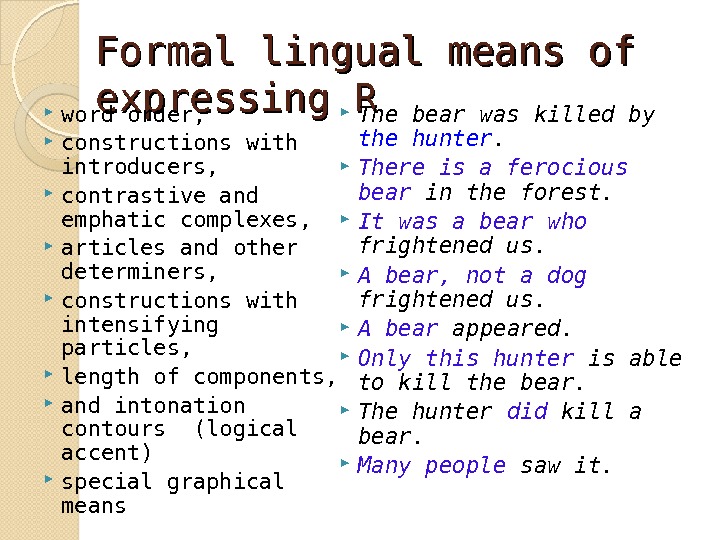
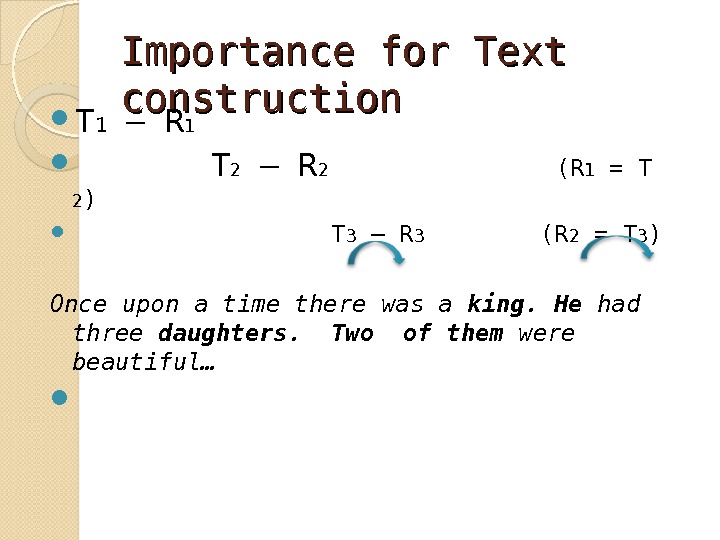
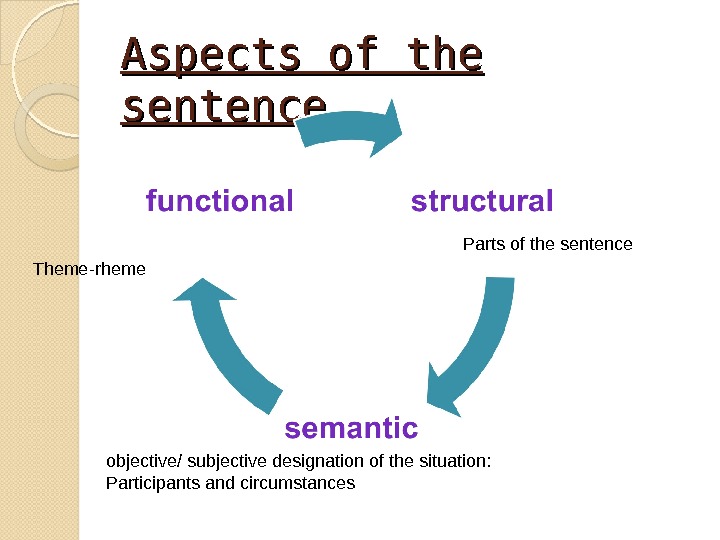
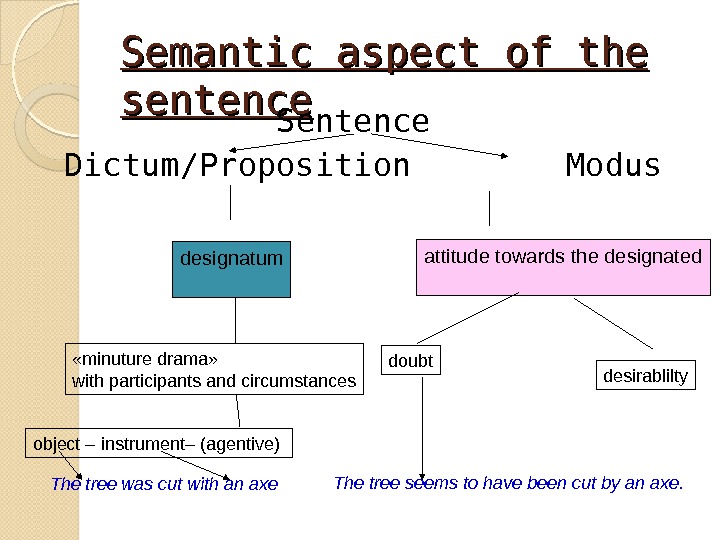
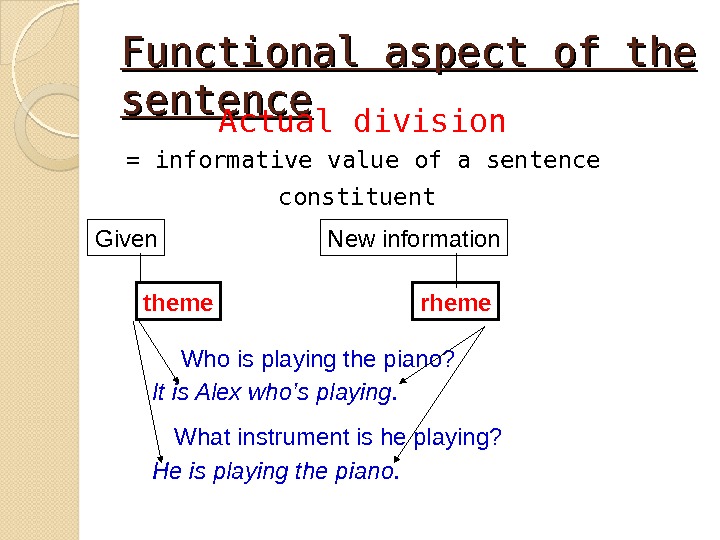
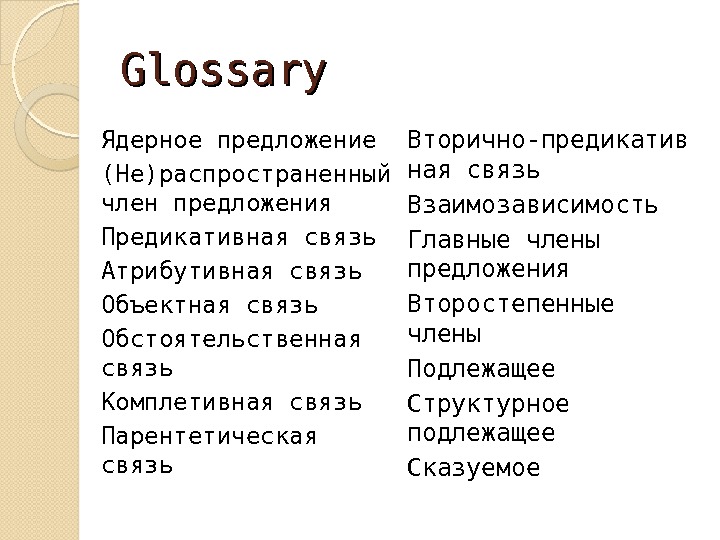
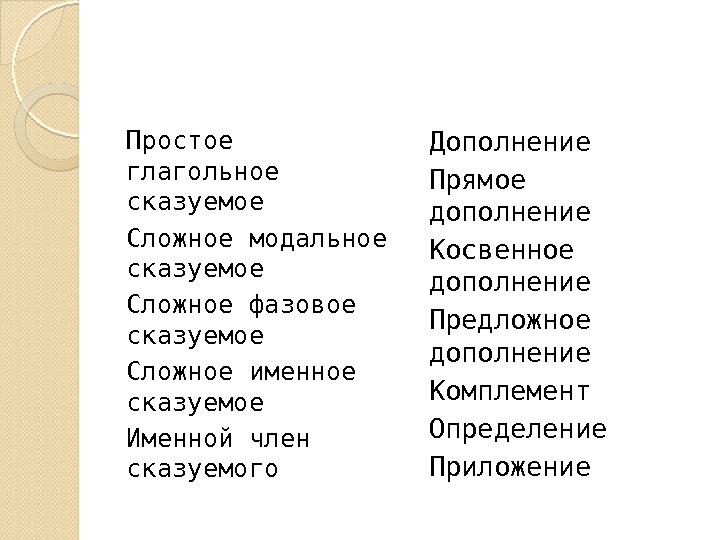
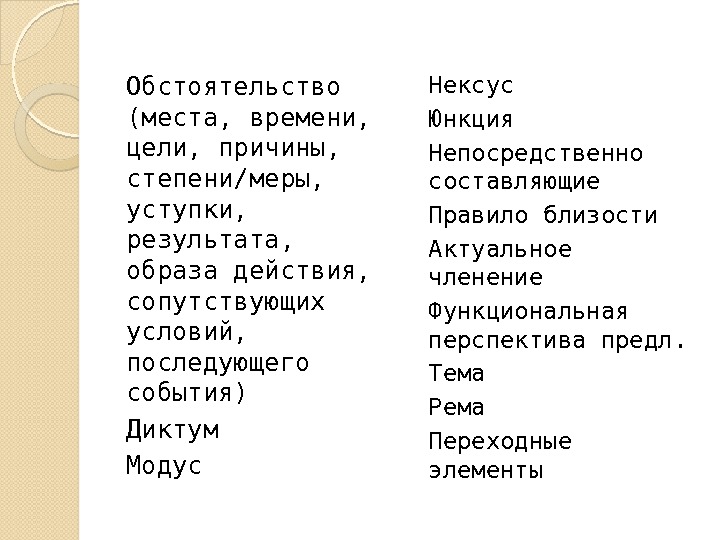
3_parts_of_the_sentence.ppt
- Размер: 2.2 Mегабайта
- Количество слайдов: 74
Описание презентации Sentence analysis Lecture 3. 1. Syntactic relations in по слайдам
 Sentence analysis Lecture 3. 1. Syntactic relations in a simple sentence. Morphologic vs. syntactic analyses. 2. Syntactic and semantic analyses. 3. Traditional syntactic divisions of the sentence. 4. Theory of the three ranks. 5. IC analysis. 6. Actual division of the sentence.
Sentence analysis Lecture 3. 1. Syntactic relations in a simple sentence. Morphologic vs. syntactic analyses. 2. Syntactic and semantic analyses. 3. Traditional syntactic divisions of the sentence. 4. Theory of the three ranks. 5. IC analysis. 6. Actual division of the sentence.
 Sentence Pattern = atomic sentence = kernel sentence Elementary structure of a simple sentence based on the valence of the verb which remains after elimination of all structurally unnecessary (optional) elements.
Sentence Pattern = atomic sentence = kernel sentence Elementary structure of a simple sentence based on the valence of the verb which remains after elimination of all structurally unnecessary (optional) elements.
 Sentence Pattern = atomic sentence = kernel sentence. Syntactic Morphological S + P + O dir S + P + O indir + O dir N + V (I think. ) N + V + N (I see the dog. ) N + V + N (I give the dog a bone. )
Sentence Pattern = atomic sentence = kernel sentence. Syntactic Morphological S + P + O dir S + P + O indir + O dir N + V (I think. ) N + V + N (I see the dog. ) N + V + N (I give the dog a bone. )
 Syntactic relations in in phrases 1. Predicative 2. Attributive 3. Objective completive 4. Adverbial I see; the night being cold happy meals closed the window to move noiselessly
Syntactic relations in in phrases 1. Predicative 2. Attributive 3. Objective completive 4. Adverbial I see; the night being cold happy meals closed the window to move noiselessly
 Syntactical connections in the sentence 1. Predicative 2. Objective 3. Attributive 4. Adverbial 5. Parenthetical (introductory) 6. Secondary predicative Frankly, I read this story in the morning paper. I find the story very exciting.
Syntactical connections in the sentence 1. Predicative 2. Objective 3. Attributive 4. Adverbial 5. Parenthetical (introductory) 6. Secondary predicative Frankly, I read this story in the morning paper. I find the story very exciting.
 Syntactic division Semantic (nominative) division Parts of the sentence ◦ Predicate main ◦ Subject bilateral dependency / interdependence Secondary ◦ Objects ◦ Adverbial modifiers ◦ Objective predicative ◦ Independent ? ◦ Parenthesis Semantic roles (components) ◦ Predicate (action) ◦ Agent ◦ (Semantic) Object ◦ Recipient ◦ Circumstances Time Place
Syntactic division Semantic (nominative) division Parts of the sentence ◦ Predicate main ◦ Subject bilateral dependency / interdependence Secondary ◦ Objects ◦ Adverbial modifiers ◦ Objective predicative ◦ Independent ? ◦ Parenthesis Semantic roles (components) ◦ Predicate (action) ◦ Agent ◦ (Semantic) Object ◦ Recipient ◦ Circumstances Time Place
 I gave him the book yesterday. Syntactic division Semantic (nominative) division Parts of the sentence ◦ Predicate ◦ Subject ◦ Objects ◦ Adverbial modifiers Semantic roles (components) ◦ Predicate (action) ◦ Agent ◦ (Semantic) Object ◦ Recipient ◦ Circumstances Time Place
I gave him the book yesterday. Syntactic division Semantic (nominative) division Parts of the sentence ◦ Predicate ◦ Subject ◦ Objects ◦ Adverbial modifiers Semantic roles (components) ◦ Predicate (action) ◦ Agent ◦ (Semantic) Object ◦ Recipient ◦ Circumstances Time Place
 I I gave him the book yesterday. Syntactic division Semantic (nominative) division Parts of the sentence ◦ Predicate ◦ Subject ◦ Objects ◦ Adverbial modifiers Semantic roles (components) ◦ Predicate (action) ◦ Agent ◦ (Semantic) Object ◦ Recipient ◦ Circumstances Time Place
I I gave him the book yesterday. Syntactic division Semantic (nominative) division Parts of the sentence ◦ Predicate ◦ Subject ◦ Objects ◦ Adverbial modifiers Semantic roles (components) ◦ Predicate (action) ◦ Agent ◦ (Semantic) Object ◦ Recipient ◦ Circumstances Time Place
 II gave him the book yesterday. Syntactic division Semantic (nominative) division Parts of the sentence ◦ Predicate ◦ Subject ◦ Objects ◦ Adverbial modifiers Semantic roles (components) ◦ Predicate (action) ◦ Agent ◦ (Semantic) Object ◦ Recipient ◦ Circumstances Time Place
II gave him the book yesterday. Syntactic division Semantic (nominative) division Parts of the sentence ◦ Predicate ◦ Subject ◦ Objects ◦ Adverbial modifiers Semantic roles (components) ◦ Predicate (action) ◦ Agent ◦ (Semantic) Object ◦ Recipient ◦ Circumstances Time Place
 II gave himhim the book yesterday. Syntactic division Semantic (nominative) division Parts of the sentence ◦ Predicate ◦ Subject ◦ Objects Direct object Indirect object ◦ Adverbial modifiers Semantic roles (components) ◦ Predicate (action) ◦ Agent ◦ (Semantic) Object ◦ Recipient ◦ Circumstances Time Place
II gave himhim the book yesterday. Syntactic division Semantic (nominative) division Parts of the sentence ◦ Predicate ◦ Subject ◦ Objects Direct object Indirect object ◦ Adverbial modifiers Semantic roles (components) ◦ Predicate (action) ◦ Agent ◦ (Semantic) Object ◦ Recipient ◦ Circumstances Time Place
 II gave himhim the book yesterday. . Syntactic division Semantic (nominative) division Parts of the sentence ◦ Predicate ◦ Subject ◦ Objects Direct object Indirect object ◦ Adverbial modifiers Semantic roles (components) ◦ Predicate (action) ◦ Agent ◦ (Semantic) Object ◦ Recipient ◦ Circumstances Time Place
II gave himhim the book yesterday. . Syntactic division Semantic (nominative) division Parts of the sentence ◦ Predicate ◦ Subject ◦ Objects Direct object Indirect object ◦ Adverbial modifiers Semantic roles (components) ◦ Predicate (action) ◦ Agent ◦ (Semantic) Object ◦ Recipient ◦ Circumstances Time Place
 I I gave him the book yesterday. Syntactic division Semantic (nominative) division Parts of the sentence ◦ Predicate ◦ Subject ◦ Objects ◦ Adverbial modifiers Semantic roles (components) ◦ Predicate (action) ) ◦ Agent ◦ (Semantic) Object ◦ Recipient ◦ Circumstances Time Place
I I gave him the book yesterday. Syntactic division Semantic (nominative) division Parts of the sentence ◦ Predicate ◦ Subject ◦ Objects ◦ Adverbial modifiers Semantic roles (components) ◦ Predicate (action) ) ◦ Agent ◦ (Semantic) Object ◦ Recipient ◦ Circumstances Time Place
 I I gave him the book yesterday. Syntactic division Semantic (nominative) division Parts of the sentence ◦ Predicate ◦ Subject ◦ Objects ◦ Adverbial modifiers Semantic roles (components) ◦ Predicate (action) ◦ Agent ◦ (Semantic) Object ◦ Recipient ◦ Circumstances Time Place
I I gave him the book yesterday. Syntactic division Semantic (nominative) division Parts of the sentence ◦ Predicate ◦ Subject ◦ Objects ◦ Adverbial modifiers Semantic roles (components) ◦ Predicate (action) ◦ Agent ◦ (Semantic) Object ◦ Recipient ◦ Circumstances Time Place
 I I gave him the book yesterday. Syntactic division Semantic (nominative) division Parts of the sentence ◦ Predicate ◦ Subject ◦ Objects ◦ Adverbial modifiers Semantic roles (components) ◦ Predicate (action) ◦ Agent ◦ (Semantic) Object ◦ Recipient ◦ Circumstances Time Place
I I gave him the book yesterday. Syntactic division Semantic (nominative) division Parts of the sentence ◦ Predicate ◦ Subject ◦ Objects ◦ Adverbial modifiers Semantic roles (components) ◦ Predicate (action) ◦ Agent ◦ (Semantic) Object ◦ Recipient ◦ Circumstances Time Place
 I I gave himhim the book yesterday. Syntactic division Semantic (nominative) division Parts of the sentence ◦ Predicate ◦ Subject ◦ Objects ◦ Adverbial modifiers Semantic roles (components) ◦ Predicate (action) ◦ Agent ◦ (Semantic) Object ◦ Recipient ◦ Circumstances Time Place
I I gave himhim the book yesterday. Syntactic division Semantic (nominative) division Parts of the sentence ◦ Predicate ◦ Subject ◦ Objects ◦ Adverbial modifiers Semantic roles (components) ◦ Predicate (action) ◦ Agent ◦ (Semantic) Object ◦ Recipient ◦ Circumstances Time Place
 I I gave himhim the book yesterday. . Syntactic division Semantic (nominative) division Parts of the sentence ◦ Predicate ◦ Subject ◦ Objects ◦ Adverbial modifiers Semantic roles (components) ◦ Predicate (action) ◦ Agent ◦ (Semantic) Object ◦ Recipient ◦ Circumstances Time Place
I I gave himhim the book yesterday. . Syntactic division Semantic (nominative) division Parts of the sentence ◦ Predicate ◦ Subject ◦ Objects ◦ Adverbial modifiers Semantic roles (components) ◦ Predicate (action) ◦ Agent ◦ (Semantic) Object ◦ Recipient ◦ Circumstances Time Place
 Types of syntactic analysis Traditional (mentalistic approach based on considering semantic relationships of the constituents) Theory of the three ranks by O. Jespersen Immediate Constituents (Am. structuralism) (mechanistic approach based on syntactic relations only)
Types of syntactic analysis Traditional (mentalistic approach based on considering semantic relationships of the constituents) Theory of the three ranks by O. Jespersen Immediate Constituents (Am. structuralism) (mechanistic approach based on syntactic relations only)
 Criticism of the traditional parts of the sentence Logical origin Focus on meaning rather than form No rigid criteria for secondary parts of the sentence; a lot of intermediary cases ( I put it on the table. ) (A. Peshkovsky) O Dpl
Criticism of the traditional parts of the sentence Logical origin Focus on meaning rather than form No rigid criteria for secondary parts of the sentence; a lot of intermediary cases ( I put it on the table. ) (A. Peshkovsky) O Dpl
 Criteria for singling out parts of the sentence 1. Semantic: general meaning 2. Morphological: grammatical form (part of speech) 3. Syntactical connection and position
Criteria for singling out parts of the sentence 1. Semantic: general meaning 2. Morphological: grammatical form (part of speech) 3. Syntactical connection and position
 Subject Main syntactic function Not dependent on any other part of the sentence In English, marked ◦ morphologically ( Common / Nominative Case) ◦ positionally (initial) ◦ structurally ( agreement with P) Semantic role: agent + other roles
Subject Main syntactic function Not dependent on any other part of the sentence In English, marked ◦ morphologically ( Common / Nominative Case) ◦ positionally (initial) ◦ structurally ( agreement with P) Semantic role: agent + other roles
 Semantic Types of Subject
Semantic Types of Subject
 Predicate Main syntactic function Action, process, state Verb / link (copular) verb + predicative Linked to the S through agreement Determines the number and kind of obligatory complements Position depends on the sentence type (VS? SV. )
Predicate Main syntactic function Action, process, state Verb / link (copular) verb + predicative Linked to the S through agreement Determines the number and kind of obligatory complements Position depends on the sentence type (VS? SV. )
 Types of predicate
Types of predicate
 Compound nominal predicate (verb complement)
Compound nominal predicate (verb complement)
 Double predicate ? V = P + link He came home tired. She married young. He was tired when he came home. She was young when she married.
Double predicate ? V = P + link He came home tired. She married young. He was tired when he came home. She was young when she married.
 Objective Predicative / Complement A secondary part of the sentence Expresses state or feature of an object Double link – with the O and VP Part of Complex Object. I found Bergson good to read.
Objective Predicative / Complement A secondary part of the sentence Expresses state or feature of an object Double link – with the O and VP Part of Complex Object. I found Bergson good to read.
 Dispute We shall do it tomorrow. simple verbal predicate. Modal verb: The right of ownership for the goods shall pass from the Seller to the Buyer… Compound verbal predicate? Different meanings => different functions: He grew potatoes. – He grew old.
Dispute We shall do it tomorrow. simple verbal predicate. Modal verb: The right of ownership for the goods shall pass from the Seller to the Buyer… Compound verbal predicate? Different meanings => different functions: He grew potatoes. – He grew old.
 Dispute: I began to laugh. ◦ Foreign linguists: object. ◦ Russian linguists: part of a compound verbal (phasal) predicate ◦ I began my work. ◦ ?
Dispute: I began to laugh. ◦ Foreign linguists: object. ◦ Russian linguists: part of a compound verbal (phasal) predicate ◦ I began my work. ◦ ?
 Dispute He made a mistake. She took a glance. 1. Phraseological unit: predicate. 2. Predicate + complement? Lexicology is irrelevant for syntactic analysis: P O.
Dispute He made a mistake. She took a glance. 1. Phraseological unit: predicate. 2. Predicate + complement? Lexicology is irrelevant for syntactic analysis: P O.
 Object A secondary syntactic function Oblique case Position: V+ O Objective link through adjoining or government? ( I looked at her / *she ). Denotes a thing or state of affairs which is affected by the event denoted by the verb.
Object A secondary syntactic function Oblique case Position: V+ O Objective link through adjoining or government? ( I looked at her / *she ). Denotes a thing or state of affairs which is affected by the event denoted by the verb.
 Foreign linguistics (R. Quirk, S. Greenbaum, G. Leech, J. Svartvik)Complement Object Nominal phrase Co-referential with the subject or object Follows the S, VP, or O Does not become S through the passive transformation. He made her career a success. Nominal phrase Follows the S and VP By the passive transformation, assumes the status of S. He made her career.
Foreign linguistics (R. Quirk, S. Greenbaum, G. Leech, J. Svartvik)Complement Object Nominal phrase Co-referential with the subject or object Follows the S, VP, or O Does not become S through the passive transformation. He made her career a success. Nominal phrase Follows the S and VP By the passive transformation, assumes the status of S. He made her career.
 Types of object
Types of object
 Direct or indirect object? He told me the whole story. She taught the children mathematics. We ’ ll help our friends to do it. He told me about it. She taught children. We ’ ll help our friends.
Direct or indirect object? He told me the whole story. She taught the children mathematics. We ’ ll help our friends to do it. He told me about it. She taught children. We ’ ll help our friends.
 OO 33 or O 11 ? ? We spoke about recent events. We bought about ten books.
OO 33 or O 11 ? ? We spoke about recent events. We bought about ten books.
 Attribute A secondary syntactic function Modifies a nominal head Expressed by Adj / N (stone wall) + Num, V (a book to read) pre-position or post-position (books interesting to everyone) Attributive connection through adjoining, rarely – agreement (these books) Characterize, qualify, or identify persons or things
Attribute A secondary syntactic function Modifies a nominal head Expressed by Adj / N (stone wall) + Num, V (a book to read) pre-position or post-position (books interesting to everyone) Attributive connection through adjoining, rarely – agreement (these books) Characterize, qualify, or identify persons or things
 Semantic function: predication A beautiful flower The flower is beautiful.
Semantic function: predication A beautiful flower The flower is beautiful.
 Dispute: Part of a phrase or sentence? Lower rank, not depending on a predicate Hasty climbers have sudden falls. Climbers have falls. My house is my castle. House is castle.
Dispute: Part of a phrase or sentence? Lower rank, not depending on a predicate Hasty climbers have sudden falls. Climbers have falls. My house is my castle. House is castle.
 Specifics of English attribute The proximity rule: Children playing in the yard * Playing in the yard children
Specifics of English attribute The proximity rule: Children playing in the yard * Playing in the yard children
 Attribute or Object? The gloom of winter twilight closed about her.
Attribute or Object? The gloom of winter twilight closed about her.
 Apposition — приложение Optional constituent of a noun phrase which agrees referentially with the nominal head: Aunt Polly, Mr. Smith, President Obama; Lake Ontario , Oxford University Philip, my best friend. Typically nouns. Additional characteristics, specification. Dispute: distinct part of the sentence or type of attribute?
Apposition — приложение Optional constituent of a noun phrase which agrees referentially with the nominal head: Aunt Polly, Mr. Smith, President Obama; Lake Ontario , Oxford University Philip, my best friend. Typically nouns. Additional characteristics, specification. Dispute: distinct part of the sentence or type of attribute?
 Adverbial modifier (adjunct) A secondary syntactic function Characteristics of the action, circumstances Modifies the V (or Adj, Adv) Expressed by an Adv or prep+N Adverbial connection through adjoining, often prepositional or conjunctive (if possible) Optional element of the sentence
Adverbial modifier (adjunct) A secondary syntactic function Characteristics of the action, circumstances Modifies the V (or Adj, Adv) Expressed by an Adv or prep+N Adverbial connection through adjoining, often prepositional or conjunctive (if possible) Optional element of the sentence
 Semantic types of Adverbial Modifiers Time ( It happened yesterday. ) Place ( He was working in the garden. ) Manner ( The machine worked properly. ) Attending circumstances ( She spoke crying. ) Subsequent event ( He went to Africa to die there. ) Degree and measure (She felt extremely nervous. ) Reason ( We stopped because of being tired. ) Purpose ( The room was used for dancing. ) Condition ( If found, the secret will be publicized. ) Result ( He is too old to be elected. ) Concession ( Though a grandmother, she didn ’ t look old. )
Semantic types of Adverbial Modifiers Time ( It happened yesterday. ) Place ( He was working in the garden. ) Manner ( The machine worked properly. ) Attending circumstances ( She spoke crying. ) Subsequent event ( He went to Africa to die there. ) Degree and measure (She felt extremely nervous. ) Reason ( We stopped because of being tired. ) Purpose ( The room was used for dancing. ) Condition ( If found, the secret will be publicized. ) Result ( He is too old to be elected. ) Concession ( Though a grandmother, she didn ’ t look old. )
 State the type of Ad. M He went down sometimes to work in his garden. He ate greedily. Lying sleepless in his room he would think about it. I was old enough to understand it. Unwilling to go back to he hotel, he went to theater. But for your help , I ’ d have failed. In spite of the rain , there were a lot of people outside.
State the type of Ad. M He went down sometimes to work in his garden. He ate greedily. Lying sleepless in his room he would think about it. I was old enough to understand it. Unwilling to go back to he hotel, he went to theater. But for your help , I ’ d have failed. In spite of the rain , there were a lot of people outside.
 Object or Adverbial modifier? He walks the streets of London. I put it on the table. Wait a minute. I was glad to see him.
Object or Adverbial modifier? He walks the streets of London. I put it on the table. Wait a minute. I was glad to see him.
 Predicative or Adverbial modifier? They are in London. A. Smirnitsky: adverbial predicate.
Predicative or Adverbial modifier? They are in London. A. Smirnitsky: adverbial predicate.
 Parenthesis Dispute: a) not included in a sentence as a constituent = loose part b) detached part of a sentence (V. Zhigadlo, L. Iofic, I. Ivanova): ◦ Gr. meaning: speaker ’ s attitude towards the content; ◦ Specific gr. connection that facilitates formal inclusion of the P. into the sentence ◦ Morphological form: modal words (Perhaps, you are right) + adv. , inf. …
Parenthesis Dispute: a) not included in a sentence as a constituent = loose part b) detached part of a sentence (V. Zhigadlo, L. Iofic, I. Ivanova): ◦ Gr. meaning: speaker ’ s attitude towards the content; ◦ Specific gr. connection that facilitates formal inclusion of the P. into the sentence ◦ Morphological form: modal words (Perhaps, you are right) + adv. , inf. …
 Structural classification of parts of the sentence
Structural classification of parts of the sentence
 Complex parts of the sentence make a specific feature of English syntax: Complex Subject : He was known to have been there. Complex Object : I saw her enter the house. Complex Attribute : This is a book for you to read.
Complex parts of the sentence make a specific feature of English syntax: Complex Subject : He was known to have been there. Complex Object : I saw her enter the house. Complex Attribute : This is a book for you to read.
 Structural classification of parts of the sentence
Structural classification of parts of the sentence
 Theory of the three ranks (Otto Jespersen 1937) Extremely hot weather
Theory of the three ranks (Otto Jespersen 1937) Extremely hot weather
 a furiously barking dog = a dog barking furiously
a furiously barking dog = a dog barking furiously
 Junction vs. nexus Nexus: a dog barking … => a dog barks Junction: extremely hot weather In the junction, the joining of elements is so close that they might be considered one composite name: a silly person = a fool The nexus, a syntactic type of predicative joining, forms a sentence (clause).
Junction vs. nexus Nexus: a dog barking … => a dog barks Junction: extremely hot weather In the junction, the joining of elements is so close that they might be considered one composite name: a silly person = a fool The nexus, a syntactic type of predicative joining, forms a sentence (clause).
 Nexus The dog barks (at the neighbors). (I hear) the dog bark. The dog ’ s barking (was heard all over the place). The dog ’ s bark was terrifying.
Nexus The dog barks (at the neighbors). (I hear) the dog bark. The dog ’ s barking (was heard all over the place). The dog ’ s bark was terrifying.
 Junction => nexus the expensive book => The book is expensive.
Junction => nexus the expensive book => The book is expensive.
 Immediate Constituent (IC) Analysis The concept introduced by Leonard Bloomfield. Aimed to analyze a linguistic expression into a hierarchically defined series of constituents. If the complex expression is movable or can be replaced in the sentence by a simple expression, it counts as a constituent. The most basic principle of transformational grammar.
Immediate Constituent (IC) Analysis The concept introduced by Leonard Bloomfield. Aimed to analyze a linguistic expression into a hierarchically defined series of constituents. If the complex expression is movable or can be replaced in the sentence by a simple expression, it counts as a constituent. The most basic principle of transformational grammar.
 The professor gives a lecture. S NP VP Det N V NP Det N The professor gives a lecture
The professor gives a lecture. S NP VP Det N V NP Det N The professor gives a lecture
 ACTUAL DIVISION OF THE SENTENCE or FUNCTIONAL SENTENCE PERSPECTIV
ACTUAL DIVISION OF THE SENTENCE or FUNCTIONAL SENTENCE PERSPECTIV
 Terms ACTUAL DIVISION OF THE SENTENCE Functional sentence perspective (Prague School: Vilém Mathesius 1929) Communicative structure of the sentence Informative perspective of the sentence Informational structure of the sentence the functional analysis of the sentence, communicative analysis, the actual division analysis, the informative perspective analysis.
Terms ACTUAL DIVISION OF THE SENTENCE Functional sentence perspective (Prague School: Vilém Mathesius 1929) Communicative structure of the sentence Informative perspective of the sentence Informational structure of the sentence the functional analysis of the sentence, communicative analysis, the actual division analysis, the informative perspective analysis.
 What is it? the informative value of different parts of the sentence in the actual process of communication showing which component of the denoted situation is informationally more important from the point of view of the speaker. Habit is a second nature. Habit is // a second nature. T R
What is it? the informative value of different parts of the sentence in the actual process of communication showing which component of the denoted situation is informationally more important from the point of view of the speaker. Habit is a second nature. Habit is // a second nature. T R
 Theme – Rheme theme ( “ the basis ” by V. Mathesius) = the starting point of communication, it usually contains some old, “ already known ” information (topic, given). < Greek the- ‘ to set ’ rheme ( “ the nucleus ” by V. Mathesius) = the basic informative part of the sentence, its contextually relevant communicative center, the “ peak ” of communication, or the information reported about theme; it usually contains some new information (comment, focus). < Greek rhe- ‘ to say ’
Theme – Rheme theme ( “ the basis ” by V. Mathesius) = the starting point of communication, it usually contains some old, “ already known ” information (topic, given). < Greek the- ‘ to set ’ rheme ( “ the nucleus ” by V. Mathesius) = the basic informative part of the sentence, its contextually relevant communicative center, the “ peak ” of communication, or the information reported about theme; it usually contains some new information (comment, focus). < Greek rhe- ‘ to say ’
 How to find the rheme? Intonation, logical stress. Contrast. Special question. Telephone was invented by Alexander Bell, not Einstein. Who was telephone invented by? . What did Caroline sing? – She sang A SONG. Who sang a song? — CAROLINE sang a song.
How to find the rheme? Intonation, logical stress. Contrast. Special question. Telephone was invented by Alexander Bell, not Einstein. Who was telephone invented by? . What did Caroline sing? – She sang A SONG. Who sang a song? — CAROLINE sang a song.
 Theory of communicative dynamism (Jan Firbas) FSP is not binary but is scalar with degrees of communicative dynamism: T has the smallest and the R the highest degree of communicative dynamism, as the R promotes the communicative process the most. transitional parts a secondary rheme, the “ subrhematic ” part of a sentence Again Charlie is late. There is a pond in the garden.
Theory of communicative dynamism (Jan Firbas) FSP is not binary but is scalar with degrees of communicative dynamism: T has the smallest and the R the highest degree of communicative dynamism, as the R promotes the communicative process the most. transitional parts a secondary rheme, the “ subrhematic ” part of a sentence Again Charlie is late. There is a pond in the garden.
 The rheme is the obligatory informative component of a sentence, there may be sentences which include only the rheme; theme and the transition are optional. Who sang the song? – Caroline.
The rheme is the obligatory informative component of a sentence, there may be sentences which include only the rheme; theme and the transition are optional. Who sang the song? – Caroline.
 < logical analysis of the proposition Theme = logical subject Rheme = logical predicate
< logical analysis of the proposition Theme = logical subject Rheme = logical predicate
 Actual & syntactic divisions
Actual & syntactic divisions
 English rigid word order is compensated by a comparatively free functional sentence perspective: R – T A woman enters. T – R – T There is a book on the table.
English rigid word order is compensated by a comparatively free functional sentence perspective: R – T A woman enters. T – R – T There is a book on the table.
 Formal lingual means of expressing R word order, constructions with introducers, contrastive and emphatic complexes, articles and other determiners, constructions with intensifying particles, length of components, and intonation contours (logical accent) special graphical means The bear was killed by the hunter. There is a ferocious bear in the forest. It was a bear who frightened us. A bear, not a dog frightened us. A bear appeared. Only this hunter is able to kill the bear. The hunter did kill a bear. Many people saw it.
Formal lingual means of expressing R word order, constructions with introducers, contrastive and emphatic complexes, articles and other determiners, constructions with intensifying particles, length of components, and intonation contours (logical accent) special graphical means The bear was killed by the hunter. There is a ferocious bear in the forest. It was a bear who frightened us. A bear, not a dog frightened us. A bear appeared. Only this hunter is able to kill the bear. The hunter did kill a bear. Many people saw it.
 Importance for Text construction T 1 – R 1 T 2 – R 2 (R 1 = T 2 ) T 3 – R 3 (R 2 = T 3 ) Once upon a time there was a king. He had three daughters. Two of them were beautiful…
Importance for Text construction T 1 – R 1 T 2 – R 2 (R 1 = T 2 ) T 3 – R 3 (R 2 = T 3 ) Once upon a time there was a king. He had three daughters. Two of them were beautiful…
 Aspects of the sentence Parts of the sentence Theme-rheme objective / subjective designation of the situation: Participants and circumstances
Aspects of the sentence Parts of the sentence Theme-rheme objective / subjective designation of the situation: Participants and circumstances
 Semantic aspect of the sentence Sentence Dictum / Proposition Modus designatum attitude towards the designated The tree was cut with an axe « minuture drama » with participants and circumstances о bject – instrument – ( agentive ) The tree seems to have been cut by an axe. doubt desirablilty
Semantic aspect of the sentence Sentence Dictum / Proposition Modus designatum attitude towards the designated The tree was cut with an axe « minuture drama » with participants and circumstances о bject – instrument – ( agentive ) The tree seems to have been cut by an axe. doubt desirablilty
 Functional aspect of the sentence Actual division = informative value of a sentence constituent Given New information theme rheme Who is playing the piano ? It is Alex who ’ s playing. What instrument is he playing ? He is playing the piano.
Functional aspect of the sentence Actual division = informative value of a sentence constituent Given New information theme rheme Who is playing the piano ? It is Alex who ’ s playing. What instrument is he playing ? He is playing the piano.
 Glossary Ядерное предложение (Не)распространенный член предложения Предикативная связь Атрибутивная связь Объектная связь Обстоятельственная связь Комплетивная связь Парентетическая связь Вторично-предикатив ная связь Взаимозависимость Главные члены предложения Второстепенные члены Подлежащее Структурное подлежащее Сказуемое
Glossary Ядерное предложение (Не)распространенный член предложения Предикативная связь Атрибутивная связь Объектная связь Обстоятельственная связь Комплетивная связь Парентетическая связь Вторично-предикатив ная связь Взаимозависимость Главные члены предложения Второстепенные члены Подлежащее Структурное подлежащее Сказуемое
 Простое глагольное сказуемое Сложное модальное сказуемое Сложное фазовое сказуемое Сложное именное сказуемое Именной член сказуемого Дополнение Прямое дополнение Косвенное дополнение Предложное дополнение Комплемент Определение Приложение
Простое глагольное сказуемое Сложное модальное сказуемое Сложное фазовое сказуемое Сложное именное сказуемое Именной член сказуемого Дополнение Прямое дополнение Косвенное дополнение Предложное дополнение Комплемент Определение Приложение
 Обстоятельство (места, времени, цели, причины, степени/меры, уступки, результата, образа действия, сопутствующих условий, последующего события) Диктум Модус Нексус Юнкция Непосредственно составляющие Правило близости Актуальное членение Функциональная перспектива предл. Тема Рема Переходные элементы
Обстоятельство (места, времени, цели, причины, степени/меры, уступки, результата, образа действия, сопутствующих условий, последующего события) Диктум Модус Нексус Юнкция Непосредственно составляющие Правило близости Актуальное членение Функциональная перспектива предл. Тема Рема Переходные элементы

